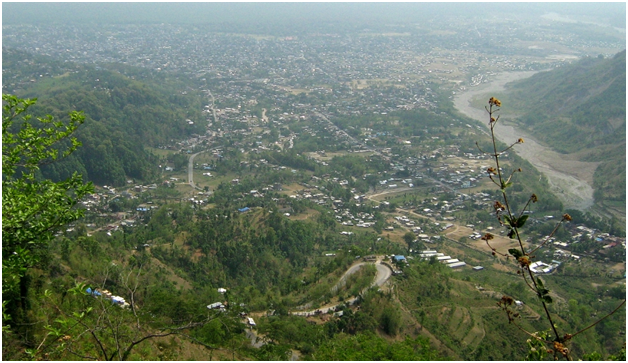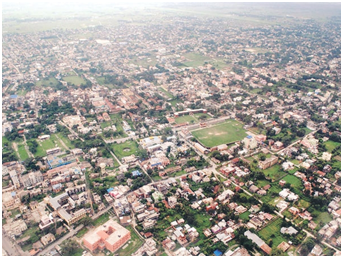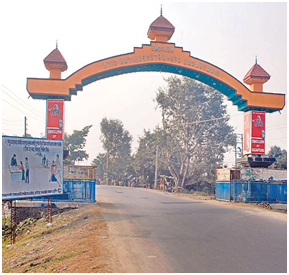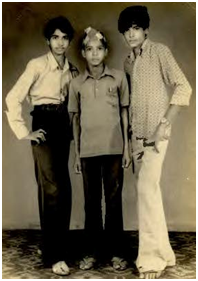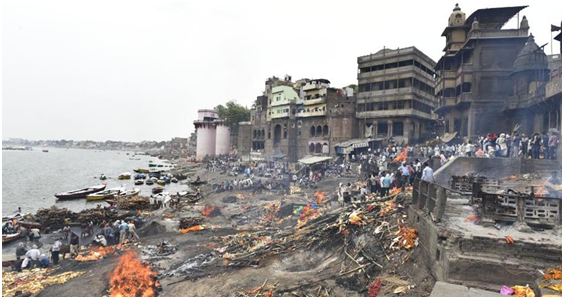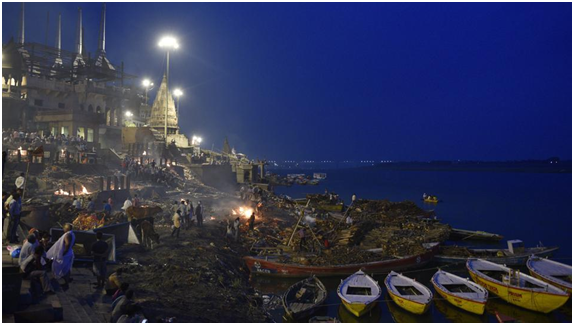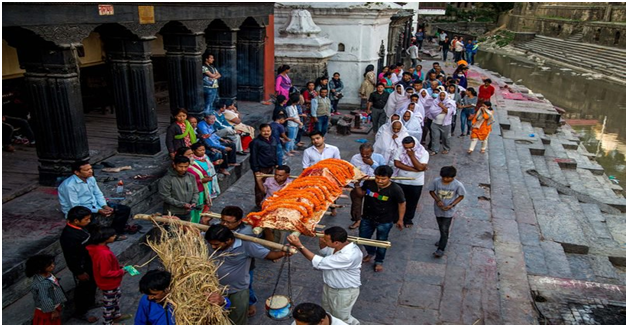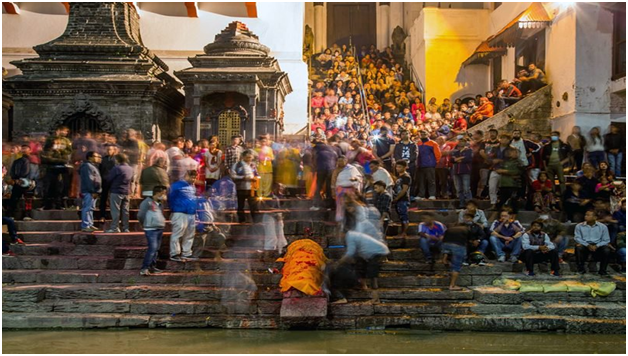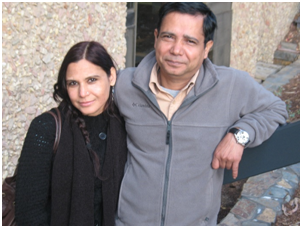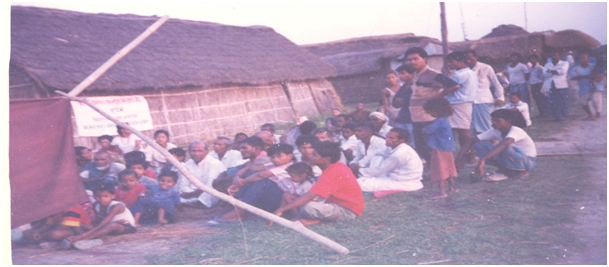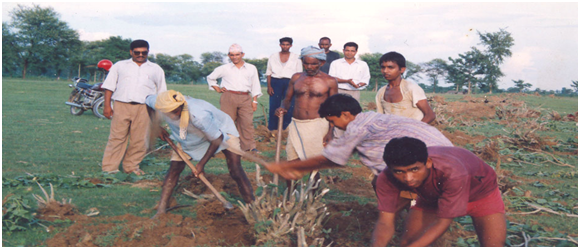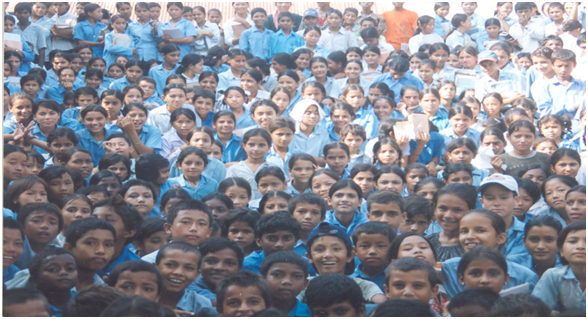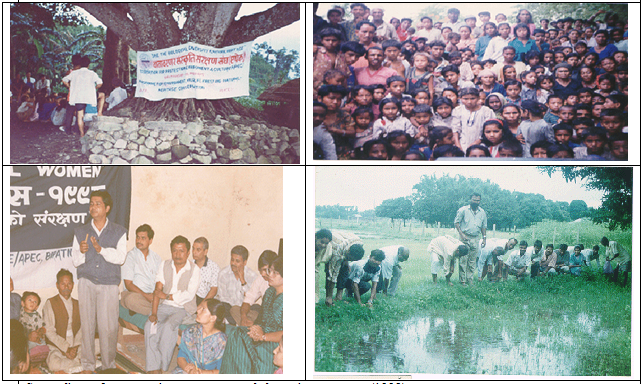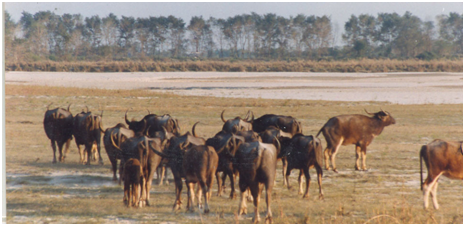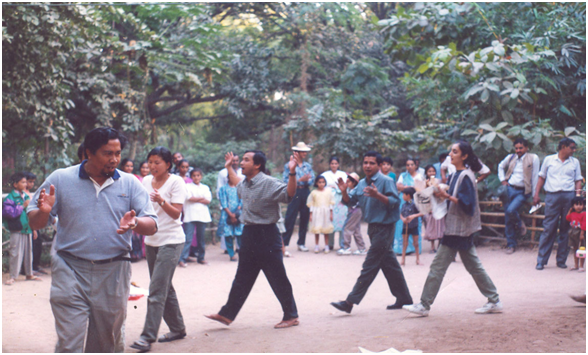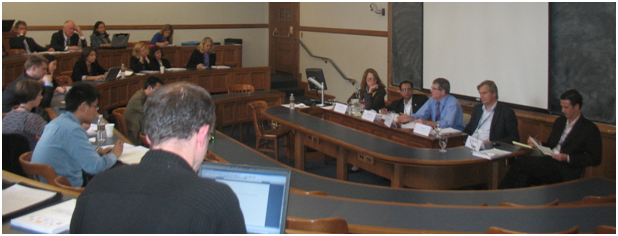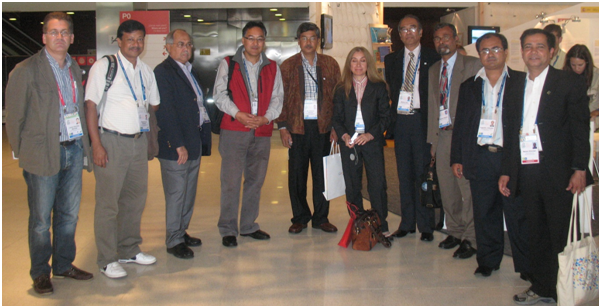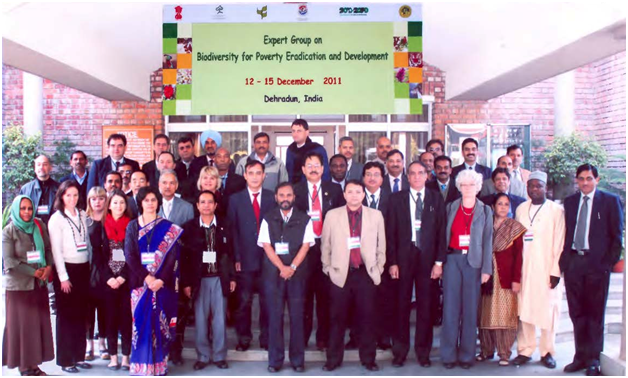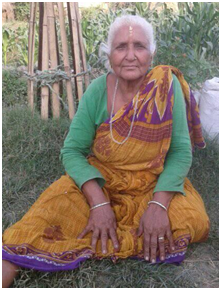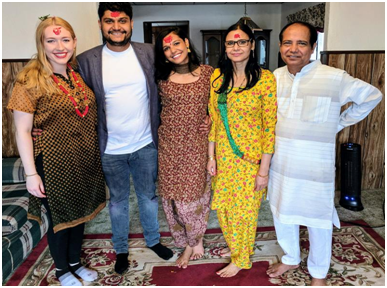Volume : 2 | Issue : 2
Interview
Live and let other live- the harmony with nature /living beings-in reference to sustainable development (SD)- is contemporary world’s economic and social phenomena is favorable for the sustainability of the planet in reference to India, Nepal, Bangladesh, and Pakistan?
Medani P. Bhandari
Akamai University, Hilo, Hawaii, USA and Sumy State University, Ukraine
Received: February 20, 2019 | Published: March 07, 2019
Abstract
This is a second-round interview, with Prof. Medani P. Bhandari. In the first interview, Prof. Bhandari explained why “VashudhivaKuttumbakam” the entire planet is our home and all living beings are our relatives in which he explained how geographical, and socio-cultural environment on personal motivation building and how he became interested in the conservation of nature and natural resources, what was the problems and how he overcome and continuously working on the same track with the same focus in his entire life. In this round, we will discuss “Live and let other live- the harmony with nature /living beings-in reference to sustainable development (SD)- and to how India, Nepal, Pakistan, and Bangladesh are coping with the agendas of sustainable development. Prof. Bhandari is a lifelong conservationist, expert of climate change impact, sustainability, social empowerment and educationalist, who has devoted his entire life for the conservation of nature and social services. This true story tells how personal background makes people’s perceptions on nature and society and what role a spiritual / tradition, Indigenous knowledge can motivate himself or herself to devote on conservation of nature and social empowerment. He also shares the essence of education- how as a poor subsistence farmer child suffered to find educational options (six hours walk for school, swim cross three rivers for schooling – only four hours sleep, experiencing death). In this interview, Prof. Bhandari explains the essence of sustainable development; but says SD is not a readymade solution of the current global crisis. There are two parts in this interview, the first part is an educational journey, second is or is not the contemporary world’s economic and social phenomena is favorable for the sustainability of the planet. This interview covers the historical account of SD, its goals and theories and practice of sustainability. Prof. Bhandari has published more than 60 papers on international journals, many monographs published and four books and poems volumes. His recent book “Green Web-II: Standards and Perspectives from the IUCN, Published, sold and distributed by River Publishers, Denmark / the Netherlands ISBN: 978-87-70220-12-5 (Hardback) 978-87-70220-11-8 (eBook)-2018” which also deals how collectively we can resolve the global environmental crisis. A brief biography and contact details of Prof. Bhandari is included at the end of this interview. Prof. Bhandari states “My intention, of life, is to pay back; give or contribute to the society in fullest whatever I have, earned, or experienced.” Hopefully, readers will enjoy reading and will be benefited from this true an intrinsic motivational story with the evidence of scientifically grounded facts.
Keywords: Sustainable Development, India, Nepal, Bangladesh, Pakistan, South Asia, Government, Climate Change, Environmental Problems, Pollutions, Floods, Landslides, Earthquakes, Cyclones/Storms, Over Population, Water Crisis, Deforestation, Plantation, Mass Media, Delhi, Kathmandu, Dhaka, Karachi, Mountain Everest, Ganges, Sea level, IPCC, IUCN, United Nations, SAARC, ICIMOD.
Journal: Questions- Prof. Bhandari, thank you for taking the time to speak with us. In the last interview, we discussed your career in environmental protection and climate change. Your response has been highly appreciated. We have received many positive comments. People, actually like your principle of “Bashudaivakutumbakkam- the entire world or earth is our/ your family”, particularly how you internalize the learned, listened and practiced rituals to make the guiding principle of your dedication for nature conservation. Your academic work and publications also show that your primary expertise is in sustainability and your environment conservation journey was embodied within the principle of Live and Let Them Live. As you indicated in the previous discussion; Your “live and let them live” meaning – as entire earth is our home, all the living beings are family, in that case not humans but entire living being have the right of survival as humans have.
In this round of discussion, firstly, we would like to start how you became interested in altruism or lenience to nature-live and let them live? What led you to make this the focus of your academic studies and your eventual long-term career? And secondly; we would like to know, your opinion on; (1) Does the contemporary world’s economic and social phenomena is favorable for the sustainability of the planet? (2) How sustainability discourses/epistemology is developing? (3) Do you think the proposed and implemented sustainable development goals of the United Nations are achievable? Additionally, (4), How the world is responding to achieve SDGs and (5) How your research focused countries, India, Nepal, Bangladesh, and Pakistan are responding to achieve the SDGs?.
Prof. Bhandari: Thank you very much for inviting me to discuss in the very important but extremely complex subject- sustainable development (SD) interchangeably used as sustainability. Sustainability as such is a complex term, sustain – survive, maintain, bearing or holding capacity and ability to be able of. However, in a definitional statement, mostly scholarly world cities from Our Common Future report (1987) which states “development that meets the needs of the present without compromising the ability of future generations to meet their own need” (Our Common Future 1987). Our Common Future asserted that people can build a future that is more prosperous, more just, more secure. The report also noted that it was not a prediction of ever-increasing environmental decay, poverty, and hardship in an ever more polluted world among ever decreasing resources; however, outlined the possible ways for a new era of economic growth, one that must be based on policies that sustain and expand the environmental resource base. It pointed out the necessity to overcome the deepening poverty of the developing world (Our Common Future, 1987).In the definitional term, Sustainability and sustainable development are used interchangeably, which builds on three major areas, Environmental Sustainability, Economic Sustainability, and Social Sustainability. Sustainability is the capacity to endure over time, through enhancing the conditions of social and natural flourishing (James et. al. 2015:22). The sustainable development notion provides the hope in the world, by reviving security in the society, providing the environment to share and cope with problems and produce goods, deliver services, maintain order, and gives a way to survive from individual level to societal stage. The sustainability notion hopes to minimize the challenges, helps to establish order in the society (Richter 2009; Meuleman 2013).
Part -one
The historical situation of Nepal, if not unique, is certainly unusual. Nepal clearly shares in the long and great history of Asian civilization, intricately involved with the Buddhist and Hindu religions. Buddha himself was born within the boundaries of present-day Nepal and much of Hindu mythology involves the Himalayan region. That Nepal formed an integral part of ancient Asian civilization is further attested to by many facts, of which the origins of pagoda architecture in Nepal and the early reference in Hiuen Tsang to Nepal in Chinese writings are but two. The unusual feature of Nepal lies in the fact that here an integral part of Asian civilization remained almost uninfluenced by colonialism, the industrial revolution, and European technology until the mid-twentieth century (Griffin et al. 1988:44).
Prof. Bhandari: Let me begin with how I become equally interested in environmental protection/climate change and sustainable development. Basically, the notion of SD emerged as the solution of global problems-Environmental Damage, Biodiversity Loss, Climate Change -Hunger- Epidemics and other numerous problems created by the anthropogenic disturbances in nature and natural resources. Epistemologically, SD covers three components -Environment-Society and Economics. When I was in high school (in the early 1980s), the environmental problems were already in discussion, so, my young mind was curious to know the cause and effects of environmental change. At least in the geo-location where I grew up, there was no access of any information on why it is happening, who were the actors, however, the elderly people were sharing negative change particularly on their agriculture and pasturing patterns. The culture, traditions, religion, socioeconomic condition and geographic environment of my childhood drew me towards SD notion (brief account is illustrated in my previous interview. In this discussion, I would only like to repeat few important aspects which empowered me to think globally and act locally, live in peace and let other live in peace, the importance of togetherness, cooperation, and collaboration. I would also like to share my experiences of how failing can motivate innovation and creativeness. And most importantly, how and what instinctive notion motivated and taught me to eternalize feelings, thoughts and thrives to convince myself, my community, nation that each living being has equal rights to live and enjoy their lives in the Mother Earth. In other word, Earth does not solely belong to human but also belong to all floras and faunas (Biodiversity). The first thing I learn from the childhood was the appreciation to “whatever we see, and feel, including, air, the surrounding, trees, birds, animal, and structure of the rock, terrain, land escape’. As I noted in previous interviews, I learn to appreciate nature, before I learn to speak and walk. I grew in the primitive kind of environment if we compare the current developed world context. I think the base of my orientation towards conservation of nature and nature, is the culture, which taught me to appreciate nature. The society of my birthplace as well as where I spent my childhood, was bonded with a religious environment. My family members and teachers of all level of education always gave me a moral education to appreciate all faith and all religions. In the later stage of education, I found that the traditional faith base and indigenous society have learned to survive with harmony with nature and natural resources. I also learn that Similar principle applies with most of the religious mythologies (Baha’i, Buddhism, Christianity, Daoism, Hinduism, Jainism, Judaism, Islam, Shinto, Sikhism and Zoroastrianism, etc.) in a different form. The way of appreciation might have been different; however, they hold the principles of Live and let other live- the harmony with nature /living beings (Bhandari 2019, Sarmah 2015; OM 2016).
In my childhood togetherness with nature and (internally) domesticated plants (agricultural products) and animal including, goats, cows and oxen, buffaloes, pigeon, parrots and (externally) like monkeys, langur, jackal, fox, snake, etc. were also an important part of the life. I feel those external wild animals also part of the day to day lives of subsistence farmers. Inherited in the farm environment, I learn a dedication, love, respect and the importance of labor (physical and mental). I saw many farmers failing several times due to unavoidable causes (flood, landslides, drought, and invasion of wild animal), losing all wealth they had, but never shown failures in the society. Those rural illiterate, poor subsistence farmers always gave me a message of, “if you keep on trying no one can stop you to reach your destiny”. Their mantra was “Failing is the opportunity for the better option”.
The understanding of without education there was no life and no future- Education to sustain
In my family, without education there was no proper life and future, however, schooling was not accessible. There was a pre-primary school (up to three grades) in walking distance, though there were no high schools within. The nearest High School was in half day walk. My maternal uncle did his schooling in Taplejung (Mountain district of eastern Nepal), a full day walks far from the house. There was no option for higher education, so he went Varanasi India for his intermediate in Sanskrit language (kind of mandatory to our family male members). He was my first teacher who taught me the alphabets, and the numbers, linking interrelationship with animals and plants of our surroundings. I follow his footpaths in the educational journey. Actually, my young brain was tuned with nature in a way that I was and still enjoy the soil smell, mountains rivers music, the vibration of tree leaves, birds’ songs and at night jackal’s crying. The subsistence farmers society taught me, why harmony with nature is essential and how nature is nurturing us without discrimination. Formally, my first school was Bijaure, Kwaku, where I complete grade three. My uncle got a teaching position at the same school where he had completed his high School “Balsubodhini Sanskrit High School, Phungling-2 Medibung Taplejung”. He took me with him, where I joined in fourth grade. It was the first time; I was away from my grandparent. At the age of nine, I had to stay alone at the hostel, collect the firewood, cook own food, clean pots, wash own clothes. I enjoyed that environment, enjoyed the company of future priests, whose first task was to learn the path of togetherness, tolerance, and harmony with nature. However, my uncle transferred from that School to another. So, I had three options, stay alone in that school, go to the same school where my uncle was transferred or quit school and stay with a grandparent. I wanted to go to the new place with my uncle, though due to the security cause my grandparent kept me with them but continued teaching the Sanskrit rituals books, Like Durga Saptasati (The praise of Goddess), The Gita and some books on daily rituals. In practical, I was out of school for three years or so, until I reached thirteen. However, those years were most affectionate timing with nature.
Turning point: The new move – compromise with the situation- adaptation
It was January 1975, my father Lok Nath Bhandari, came to take me with him. I knew very little about him. He was a highly respected person in the society. The distance between my father’s house and my grandparents’ house was a full day walk. For my father, my grandparent’s place was like his own neighborhood. Everybody knew him as their own family member, because of his involvement on social empowerment through education. Whenever he used to visit his father in laws place, he was always welcomed by the community.
Through the conversation between my father and my grandfather, I learned that I was not going to my birthplace, but to the new location, to Tarai (plain, flat land of no mountains). Actually, by then, my mother, grandmother (father side) and my brothers and sisters were already moved to the Tarai. The distance between my grandparents’ house to the motorable place was four days walk (there were no other means of transportations).
It was one of the most difficult time of my life. I was leaving the lap of my grandfather and grandmother and the surrounding, friends, animals, the trees like bamboos, banana and mango and many more. While I was with my grandparent my resting place in the day was a place made in the dense canopy tree branch. I did not agree to go with father in the beginning, however, my father and grandparents convinced me, so I agree to go with my father wherever he takes me. Within two days, I had to leave the place where I grew up. Finally, the day came, and we get ready for the new journey. Before we departed from my grandparents’ house, I went to that big mango three, hugged and cry almost an hour. I also talk with all animals (cattle and felt that they all were crying and sending a message that we will not see each other again). Particularly, a dog (Rede) who was sensing something different. I had so much love and affection with the place, people, animals, and plants. I had a feeling and trust that their love was even more than I loved them. I used to think that the surrounding is always worried about me and they always bless me. Finally, I had to follow my father. We left my grandparents’ house early in the morning; because there was a certain distance to walk to reach a place where we can spend a night for next day journey. After four days of walk, we reached to Dharan, a business hub for the mountain of Eastern Nepal.
Before, reaching to Dharan (situated on the foothills of the Mahabharat Range in the north with its southern tip touching the edge of the Tarai region at an altitude of 1148 ft, It serves as a trading post between the hilly region and the plains of the Tarai region) from the top of the Saguri Bhanjyang (last mountain between Mahabharat range and Tarai), which touches plain area, I saw a never-ending flat. It was so amazing unbelievable -scene beauty. From Saguri Bhanjyang- One can see the Saptakoshi Rivers (the largest River in Nepal, flowing in Tarai), Dharan City, the forestry of surrounding mountains and the remote glimpse of Tarai Forest. To reach to Dharan from Saguri Bhanjyang, it was three hours steep walk (now no one walks that way, because of the Motorable road to Dhankuta). The scenic beauty of the mountain was common for me, but I have never seen the never-ending plain area before. After three hours walk, we reached to Dharan gateway of Tarai and mountain, where I saw a different world which I have never seen and thought before. There were wide roads, bus, trucks, car, motorcycle, etc. However, I had no idea that those automatic moving various shaped things.
Real for me but a joke for others- life without a wheel and with wheel
When I saw a bus for the first time in my life, I ask my father “what is it” and “how it works”. He told me “it is like a moving home”, “it keeps people inside and runs”. I did not see any long legs to run, so asked my father about the legs. He pointed black wheels and said to me “these are the wheels, operated by a machine, they roll”. I asked him how they can move, he told: “they need the energy to run as we need food and drink”. “Their food is oil (petrol), water to cool its body”. While we were talking, people were glaring and laughing at me. I asked my father about this odd behavior. He simply laughed and told me, “you will know by yourself, after a while”.
In the meantime, I saw another huge wheel standing machine, rolling with a very loud noise, discharging black smoke from its bottom. I asked about this and my father simply told me, “it is kind of male machine which carries goods from one place to another as mule or horses do in the mountain”.
I was very amazed and also shocked by this new world. On the roadside, there were very high poles, each of them was connected with wires. White ball like pots was hanging in those poles. I had no clue about those, poles, wire, hanging pots, etc. Most surprisingly, those wires were also connected with houses. I asked about those connections through the wires (between poles and houses) and my father simply told me that “these wires circulate Bijuli (electricity), which provide light at night”. So many new structures, some of the house’s roofs were flat, could not imagine how rainwater could be drained from, etc. So, crowded, noisy; cows, dogs, pigs, people, a “moving house” like things all in one place; I felt nothing is organized here. People were cooking in the open field, eating, drinking and even some of them were singing. I had no clue how they were such undisciplined.
Father- mother unconditional love- no way to pay back to them, but efforts can make them happy
My young brain was very tired. Whenever I asked any question to my father, he always gave me static but duel meaning answers. I was happy with the answers, however, very upset with the people around us. Any question, I asked, the people around us, either glared or laugh at me. I felt bitter with these people and also got very nervous. I had many questions to ask, however, also feeling some very strange atmosphere. In my grandparents’ house and neighborhood, I was considered as a disciplined, lovely, helpful boy, where everyone was willing to help, response my questions and show the path. My feeling was that even tree loves me, the wind blows to cool me, and soil has a smell to fresh my mind and brings love to me. Here, I did not feel the love and encouragement and willingness to help each other. I felt I do not belong to this world, or they do not belong to me. I was kind of restless, paranoid and panic. I begin to cry and asked my father to take back to my grandparents’ house. My father was kind of worry, I guess. He was telling me do not worry, this is a new environment but the same world. He was convincing me, “I will see soon my mother brothers and sister and grandmother”. Though I was a little consoled, I had no connections and affection with them.
A noise, new movements, and move- on the wheel- mechanical world
While I was crying, with a loud noise, a bell rang. Everybody gets up and begin to move close to the moving machine (Arathan Bus). With my father for the first time; at the age of 13; January 24, 1975; I ride the bus from Dharan to Biratnagar. There were about sixty people in the bus. I sat on the window side. I saw several such buses and also small moving houses (cars) with the mouth like features in both. I asked about them, my father simply said, “consider them as baby buses, for now, though you will know everything in few days” (my father was just consoling me with all possible ways).
The move on the wheel was an amazing experience. The bus stopped in several places, many people got in, got out. First, the bus crossed the Dharan city, inter to the forest for 15 to 20 minutes, reached to Tarahara, a flat agriculture land, Itahari, a small town, Duhabi another town and cross a large gate written Welcome to Biratnagar. In two hours, ride, I felt, that I traveled the world reached to another world. I like the ride, I felt like flying on air. Finally, we reached to Biratnagar at 7.00PM, the birthplace of the industry in Nepal, a district headquarters of Morang district, an attractive dream city for the residents of rural villages. I had no idea, where I will spend my most productive youth, in the future.
Once we reached to Biratnagar, I realized that the poles and wires connected with each other were standing and hanging with the purpose. The hanging white round pots (bulbs) were producing light, very bright. Roads have street lights. Houses were connected to each other. In the mountain where I grew, the difference between one house to another was about 15 to 20 minutes’ walk. It was a cold night, so I did not saw many people walking in the streets.
The first time, I saw Rickshaw (three-wheeled passenger cart, called a pulled rickshaw), we sat on it and man drive it through its pedal. Still, it is convenient transportation in Asia. We reached to one of our relatives’ house, Narayan Prasad Khanal (a well-known educator). He was also moved from the Mountain to Tarai. He was one of the most influential persons in my life.
The life in the flat, Tarai (Mountain boy in the flat landscape)- wheel-wheel, wheel- no life without wheel
Next morning, we left Biratnagar for our house to the rural village called Babiya Birta (still my two brother’s family, my sister and my mother staying in the same house). We ride a minibus for half an hour. When we got off at the bank of Lohadra River, we were almost buried by dust. There was no bridge on the river. So, we crossed it by walking (water was up to my neck in the river, but no current). There was no road, no walking tracks, we had to follow an imagery path. We also crossed several other small rivers on the way. We cross about 15 KM recently harvested paddy field. Throughout this walk, I saw many tall trees (Soria Robusta), mango, Guava, Litchi, Bamboo and Banana plantation and many varieties of tree, I was not familiar with. After three hours walk, we reached to the bank of another small river. The river banks were all covered by big or small trees, shrubs, and bushes. From the bank of the river (KUTKHOLA), my father pointed me a few houses on the other side and told me that one of them is ours. Finally, we reached home. The house was totally different than my grandparent’s house in the mountain. The mountain house was built by stone and mud, very nice, with the white paint on the wall and red in the windows and doors, covered by the stone wall. Here, the house was standing on the wooden pillar. The ground surface was for cattle and the first and second floor for us. Wooden, wall wooden floor and wooden balcony with rice hays roof. When we reached home, no one was there. My father loudly called to my grandmother and informed her that we are at home.
First time with the family- pain and joy travel together- in fact, there is no pain and joy- it is kind of state of mind
After a while, grandmother arrived with the bundle of green grass on her back, followed by other family members. I saw grandmother, mother and uncle, and auntie (I have seen them before) and my brothers and sisters for the first time. The new rural village house was nice, no electricity no paved road, (but with a wide mud road), though there was an animal pull cart. The new house, new environment, even sisters and brothers were new to me. All of them were looking at me as an unknown person. However, one of my sisters, who is dumb (unable to speak), was behaving as a close friend and had a lot to tell and show. She symbolically asked me to follow her. She took me to the ground floor where cattle were kept. She showed me how she feeds them, how she cleans the dung, how she orders to goat and so on. There was another member of the family, the Dog, Gole, who immediately accepted me as his friend and began to follow me.
Sustainability-idea flourished with real work as a subsistence farmers son
I began a new life as a son of subsisting farmer. The life as a grandson of a priest was already past. I was a new person. The first task was to get to know family members and follow what they are doing. The foremost thing, I learned was to take care of the domestic animal (take them for grazing, collecting grass, feeding them, cleaning dung). I had to get up at 4.30 AM, ride the buffaloes (with my 9 years old brother), and take them to graze in the morning dews. I like sleeping on the buffaloes back. Quickly I learn to plow a field, harvest the crops and operate the cart pulled by male buffaloes, which was only the way of means of transportation in the rural village. In the mountain, all man and women were kinds of porters, here potters were either oxen or buffaloes and frequently man and women for daily requirements.
School in a new environment- situational problems can be guiding principles for perseverance person
Locally, my father’s name was Master Baje (teacher). He had no official job as a teacher, however, his motto was to educate locals (children and adult). He had opened a primary school- named Dhule School (dust school). The dust school mean, teaching and writing in using dust. There were no board, chucks, duster, pens, pencils, copies or books to use in teaching. The children had to gather under the trees or on the open space. So, called literate people used to teach them how to read and write using the dust floor. I never saw my father teaching in those places but learn that he had made a mandatory where everyone who knows to read and write had to contribute their time to teach kids on a rotation basis. I had no idea about his educational background, though he was considered a literate person in the society. I asked my grandmother and mother about my father’s qualification, but they said it was not my business. I also asked the oldest member of our neighborhood, “why they called my father Master Baje”?. How one can be Master Baje?, even he was not teaching in School? He told me that to be a Master Baje (baje means like an old man-like grandfather, my father was not old) you do not need to teach in School, but you can make the whole community as learning ground. According to him, my father was trying to empower society through education, cooperation, dialogue, and social empowerment. Whatever was the cause, I wanted to be like my father “Master Baje”.
Continuing School was only the way to be a master Baje – following the route- saves the identity
I learned from my family and friends that, to be a teacher (master), I need to go to school and complete (minimum) 10th grade and pass the School Leaving Certificate, taken by the Government. I asked my parent about the school’s where about. I learned that there was a primary school (up to sixth grade) in walking distance “at Ranjani”. I went to Ranjani Primary School for admission in sixth grade. They asked me for the certificate of five grade completion. I had nothing to prove that, so the school administration did not admit me in the first attempt. I cried, tried to convince them and told them that I will prove, but they did not listen. I went again the next day with the same request, but again they ignored. I did not give up, I began to reach school exact time at 9.00AM and stay at the ground until 4.00PM (up to the close) for a week or so. Even I used to line up as other students used to do for the morning prayers, take part for the morning parade and physical exercise with them, though still I was not allowed to get into the classroom. About 15 days or so, I was regularly reaching to school on time, staying outside until the close.
The dream come true- the lucky day- nothing is impossible for dedicated and decided person
It was Sunday morning; as usual, I reached to school around 8.45 AM. Classrooms were opened, but only a few students and teachers arrived. One of the teachers, who was noticing me for the last 2 weeks, asked me to follow him. He took me to the headmaster’s office. Headmaster told me, that they can arrange a qualifying exam for me. He told “if I pass they will admit me in grade six and if I fail then they will admit me in grade five”. I said yes, appeared in the exams. According to them, “I was very poor in the exams, could not even write ABCD up to Z and also 1, 2, 3 up to 100”. I was supposed to learn ABCD and 1, 2, 3, (English), in grade five. However, my Nepali reading and writing were good. I was even able to write and read Sanskrit rhymes. So they admitted me with the condition. I had to improve my English skill as other students in the quarterly exam. If remain weak they would place me in grade five, if I perform well than remain is the sixth grade. It was the first challenge, though in the quarterly exam I top the class in English and Math.
Sleeping on the water buffalos back was heavenly – anything can be excited and pleasurable, just need to be with the reality and rational
As Normal schoolboy, my daily routine was to get up at 4.30AM, take male buffaloes to graze in the morning dews, bring them home by six, plow land about one and half hours, eat whatever is at home and run to the school. One aspect, I never forget, while running to school, I had always severe stomach pain. Most probably it was due to the actual run after food. Do not remember why but I never walk slowly (always run). There were several my aged boys and girls in our neighborhood, however, I was only one going to school. I tried to convince them, but no success. Basically, they did not want to take risk of crossing Koceni River and other rivers of our neighborhood on the way to Ranjani. They told me that they do not have time, and also their parent will not allow them. In fact, even to me, no one asked me to take the risk, however, my parents were happy with my decision. They never said me do or don’t do. Even, the work I used to do at home was my own choice. The school year for grade six passed so quickly. I passed six grades with good marks. I had another challenge now. There were no high schools within normal walking distance. The wealthy families of our surroundings used to send their children to Biratnagar for high school, however, my parent had no means for that.
In any case, I wanted to continue my study. I was very panic, though trying to find a way to continue. I shared my situation and willingness to continue school to my friends who just completed the six grades with me. Mostly the girls of the class were ready to quit the school, however, four boys were planning to go to Rangeli (Public Secondary High School), in three hours (one way) walking distance from Ranjani. It was kind of great relieve for me. I realized that, to somehow, doors are not closed, the path might be difficult, but nothing is impossible for the risk taker.
Six hours (two-way) walk for school – hardships can be joyful
There were two choices with me, quit the school and work as a farmer boy, or join the walking group for the school. Joining the walking group was very risky, because before I could reach to their place Ranjani, I had to walk alone for about an hour, need to cross several water bodies and a river Koceni. Even more, after meeting friends in Ranjani; together we had to cross two major rivers, Cisang and Lohadra on the way to Rangeli. I decided to take a risk and asked for my father’s opinion. He knew my feeling and willingness to continue school. He just said, be very careful and brave and do what your heart and mind guides. I got a feeling of affirmation and thought that if my parent’s blessing is with me, I can easily continue my school. I had some fear with Cobra (Snake very common), crossing several water bodies and rivers, however, I always try to remember JO DARA WO MARA (one who feels fear he is dead).
Finally, I got admission at the Public Secondary High School, Rangeli. Quickly, walking six hours every day for school, including crossing three rivers by swimming became normal life. I was happy, enjoying the new way of an adventurous life. However, in the mid-term exam (half-yearly), I rarely pass any subject. My all teachers who have strong sympathy and love to me were upset.
I never forget the sentence of Deputy Head Master called Baccha Babu “Bahun Baje (in Hindu caste system to say Baje to Brahmin boy was common), you are one of the best students in our school, we see your willingness to learn, take a risk; however, time is not supporting you. You need to challenge the time and learn to swim an anti stream.” He further said, “swimming against the current is not possible for everyone, but I feel you can do it”. He also gave an example of Indian Prime Minister Lal Bahadur Sastri who had to cross Ganges River, for his advanced study.
No idea, why, I got the feeling “I will make it” but how? I had no answer: when there is a question there is an answer- just needs more digging
In reality, I had no time to do any reading at home, and I was not able to focus on the classes. When we reached to school walking three hours, actually, we all used to get very tired. Even fall asleep during the classes.
Normal School day, (School hours 10.00AM-4.00PM) the a daily routine was, leave bed at 4.00AM, graze buffaloes for an hour or so, eat leftover food, get ready and start for school at 6.00AM, reach school about 9.30AM, attend school parade and prayers, attend class from 10.00AM to 4.00PM (half hour lunch break); leave school at 4.15PM, reach home around 7.00 to 7.30PM, depending on the weather condition. Once reached home, I had to do help my mother and my sister (dumb) to feed the animal and clean the dung.
Summer school day, (School hours 7.00AM-1.00PM April, May and June) the daily routine in the summertime, was even difficult; 3.00 AM leave the bed and 4.00AM leave for school, reach school around 6.30AM and leave school about 1.15PM. Because of the trees canopy the path used be still dark in 4.00AM. During this time March to June, the weather in Tarai remains very harsh, hot, and humid about 33 to 35 Celsius (relative humidity 99%). The thunderstorm, heavy rain, fast flood, heavy wind, if not raining than fire is the common problem during this period. So there was no guaranteed time for reaching home. I remember, several times, we were even not able to return home from Rangeli and spend nights in the local Dharmasala (religious rest house), without food.
No time to focus on the study- the alternative is always there- if one door is closed another will be opened, if not one can make her or his own door- pathway
Actually, we had no time to study and only attending school was not sufficient to pass the classes. I was very upset (actually all of us), but we were not sharing our weaknesses to each other. I was kind of restless. One of my friends noticed my unusual behave and asked for the cause. I told the truth, “I could not pass even a single subject in the half-yearly exam”. His situation was not different than mine. We shared our problem among the walker. This discussion broke the silence among us, and we learn that almost everyone had the same problem. In our walker group we were 10 students; 2, 10th grader, 3, 9th grader, 2, 8th graders and three of us seven graders.
Once we all shared our poor performance in the classes, it created a different but very friendly environment among us. We all did the brainstorming to find a way to improve our performance in the classes. There were only a few options (1) find a teacher for tuition- but it required the money and time (2) devote more time in studying at home, we had no time and no one was able to help us (3) get help from each other within the walker group. We all agreed on the third choice. The senior 10th graders agreed to help us as much as they can, during the walk an extra three hours on Friday after school (school hours on Friday was 10.00AM to 1.00PM).
Walking as tutorial time-when there is will there is a way
Our walking time turned as tutorial time (teaching verbally). As soon as we gathered in Ranjani on the way to Rangeli (school), our first task was to share the privies days’ class topic and the assigned homework. We used to share what we know and what we do not know. By sharing this, half of the problem used to solve within us. For the difficult questions, we had 10th and 9th graders to help us. Walking tutorials gave us new energy. We learn to trust, willingness to contribute, belonging and love within us. We had only one goal to learn and grow. We establish a routine for laud readers. The funny part was if one of us was reading, one of us has to hold his hand to guide him to walk. The readers normally acted as a blind person, because he or she could not see the path while reading and walking. It created a very close relationship among us (which is still alive among that batch). The laud walk reader was considered as a blind person, and a person who was holding his hand was the eyes for him or her. This was also a great lesson of coordination, cooperation. Through this exercise, we not only improved our performance in the classes but also learn to admire, trust, forgive, love and depend on each other.
This walking and reading tutorial system gave us a different way in our thinking pattern “the feelings of togetherness”. We all were equal beneficiaries, the blind readers, listeners, the guide, the seniors and we juniors. In addition, to focus on study, we also discussed how this long walking together can be memorable for all of us.
Walking six hours for school, with bare feet-with heavy book load- and swim crossing three rivers was normal- mission guided mind always empowers physically and mentally
During six hours walk for four years (grade seven to ten), we had to cross three major rivers, several small water strips, a bit of forest and scrub, elephant grass (tall grass), sand dome, mud land and in the rivers banks, wetlands and mostly the agricultural lands. On the way to school and home, we had also to cross several farm villages. All people on the way knew us by names and if one of us were missing in a particular day, they used to ask his or her whereabouts. In reality, the entire pathway’s neighborhood became our well-wisher community. The family members of our pathways were fully aware of our arrival time to their neighborhood. They knew that we were young poor sons and daughters like they had. They knew how challenging and a risky long walk to school was. Due to the Cobra abundance on the path, walking bare feet and legs [mostly we used to wear half-pants (some of us had sleepers to wear, was easy to walk bare feet)], was very risky particularly during the hot season. During four years of school, we lost about five friends due to Cobra bite and fast flood. It was also very risky to walk on the wetlands, one never knows the depth of water in the marsh. The local people were always ready to help us on the way to school or home. In several incidences, during the storm or flood, they gave us food and shelter. They loved us without expectations and they loved us unconditionally. During our walk, we ate their fruits (Mango, Banana, Custard Apple, Gooseberry, Lemon, Lime, Lychee, Musk-Melon, Papaya, Peach, Plum, Pomegranate, Tamarind, and Guava or whatever was available) and raw vegetables (Carrot, Cauliflower, Cucumber, Green Gram, Radish, Sweet Potato, Tomato, Turnip, Lack-eyed pea etc.). It was not a moral deed, though teens are teens. Of course, they were not happy with these unwanted behave, though they never took our act seriously. We just ate, on the way whatever we found, but never, took any fruits or vegetables with us. In fact, they tolerate us like their own kids. They were very kind to us all the time.
Giving whatever, one possesses without expectation gives heavenly pleasure- way of sustainable living
We knew that always wanted to do something for them to please them. Occasionally, we used to give our 10 to 15 minutes of time, particularly during our return to home, by helping to collect the rice hay, riding trees to pick the fruits, or picking the ripe vegetables. It was a small deed, but it gave us great pleasure.
There is always variation between rich and poor, (strong and weak) in most of the society- which hatred, satire, bullying, dedicated one does not care what other people say
In school, we were three types of students. The first type, the sons and daughters of rich farmers or business holders, who had houses within the Rangeli city area; second type, mostly boys of rich families, who could keep them in School hostel or in a rented apartment and third type- who come from far or by walking. Within walkers, there were two types; first whose walking distance was within an hour; second whose walking distance was more than an hour and had to cross the rivers. We belong to the second category. The hostel boys and the girls and boys of within Rangeli had nice clothing, shoes or sleepers. Walkers had different outlook; mostly dirty and wet clothing, no shoes and sleepers. We, long walkers, were even worse, normally our clothing used to be dusty or muddy, with bare feet. The good outfit students did not like to sit on the same bench with us. They used to say us that we walkers smell like dog urine, or donkey urine (that might be true). There was kind of unseen tension between us. Many times, they (the clean clothing friends of ours), misbehaved with us, but we never confronted. We, walkers, knew that we can’t compete with them in clothing, though we can beat them in studies, grades and games. There was a ranking system in the class, like first in the class, second in the class, third, fourth………..and so forth. We always obtain a better position in class ranking, extra curricula, and school games. Though there were unseen competitions within. In my batch (7th to 10th) as far as I remember only three students from the clean group managed to reach the university level of study. However, from the walkers’ group, about 75 percent complete graduate studies and are in the senior positions in their professional lives. To be in scarcity is terribly difficult, however, if one has perseverance, trust, and wiliness, it will not stop to move ahead. Both pain and pleasures are temporary for dedicated individuals.
Though, we were dirty; badly smelly; unorganized; frequently late in the classes; even fall asleep during the classes; our teachers always admired and encouraged us. Teachers were aware that “the teaching is the most important contribution” to society and the world. They always used to say your physical appearance matters a lot in the school environment; however, your mental strength matters to the society, country and the globe. Physically, six hours walk to the school was very difficult, very risky, but was one of the best times of our life “we learned to live in hardship” in fact that is not over yet.
The four years of high school ended after the district level 10th grade exam. It was a getaway for the final School Leaving Certificate (SLC) exam conducted by the government. There used to be only a few locations for the SLC exam (centers). Our school’s center was in Biratnagar. I appeared at the SLC, however, I could not pass in the first attempt. The countrywide passing ratio was only 10%. From my school, only two of my friends passed. I was very disappointed. However, I knew it was not the end of life (though two girls from our school commit suicide, due to SLC fail). I began to prepare for another attempt. In the meantime, I also begin to look for a job (for the junior level clerk 10th grade was minimum qualification). I appeared a job exam as well as the second time for the SLC exam. I passed both written and oral exams for the job but again failed the SLC. I join job as a junior clerk at the Agriculture Input Corporation (government own office), in Itahari, half hour bus ride from Biratnagar. I rented a room in Biratnagar and compute by bus. In the meantime, I also continued preparing SLC for the third attempt and pass with the lowest grades (the SLC- the iron gate of Nepal Education system).
Failing and falling is not an end of the story but a beginning of new, and pathway
Passing SCL is the main gateway for higher education in Nepal. Many people even now, who fail for the first time, they fear for the second attempt and rarely only a few tries for the third time. Many boys and girls commit suicide if they fail the SLC. The situation is not changed even today. However, now a day there are some other options for the SLC failures too. In Nepal until 2015, there was division system in the SLC result. The Distinction Level, first class, second class, third class and partial. My category was the lowest. Normally, with such lowest SLC rank, it is very difficult to get the admission in a good college. I was aware of that, still, I tried to get admission at the Mahendra Morang College but rejected. In the same year, a new night college was established. I got admission for the intermediate of Business management at Adarsha Night College. By then I had already full-time government job, and the night college was the best option. I was young and new in the job and tasks for the junior is always heavy. My tasks were to maintain office records, serve as a storekeeper and sell the agriculture-related materials (seeds, fertilizers, insecticides, equipment’s, etc.) to the farmers and manage the money. Additionally, I was also in charge and storekeeper of pesticides (including baggage handling). Maintaining the pesticide warehouse was very risky and challenging. The task included to stay hours and hours at the warehouse to keep the aisle attractive, clean by arranging 50 kg bags of DDT (dichlorodiphenyltrichloroethane), boxes of Malathion, Deltamethrin (in dust form), Parathion, called " Metacid (Methyl parathion) and Nuvan (Dichlorovos)” and many other brands. Mostly after arranging these pesticides in the warehouse, I used to have a very strong headache, even vomiting and feel drowsy. It was the probation period of my job, so I could not say no to my senior or even to the farmers. I also had to work off hours during the crop plantation, flowering and harvesting times. I was fully occupied. However, I tried to attend the night college and appear on the first year’s intermediate college exams. Out of five subjects, I passed only three. I realized that, with a full-time job, it would be very hard to continue college in the faculty of business management.
I was not in a position to resign the job, and also didn’t want to discontinue the study. I was trying to find a way to manage both, was impossible, by following the flow with the current tactics. In the night college, I was not only, who was doing a full-time job and studying. Some of my friends successfully passed the first-year exams. I was kind of jealous, with them. I began to search for other options and also began to think about my own weakness. After evaluating myself with discussions with professors, I realized that my field of interest is not business management. My interest was in core science biology and math, though it was impossible to get admission in science faculty due to my poor grades (rank) in the SLC. Therefore, the only remaining option was to go in the humanities and social sciences. I was very much disturbed and remained panic all the time. My boss at the office asked me the reason. I told him the truth, though he had no readymade answers.
Sharing a problem is not an act of shame, sharing is mutual beneficiary all involved- harmony and compromise with the existing situation
As I shared my problem of failures during high school, I did the same “sharing the problem of failure” with my colleagues in the office; friends and professors in the college. This time I also shared my problems with the family members and relatives and neighbors. The first advice was to change the path from business management to humanities and social sciences. I accept the idea, however, I did not feel comfortable to be again the first-year student, while my friends were already in the second year of college. I got to know that, there is the system in India, where students can appear intermediate college final exam after 2 years of SLC. However, to appear that exam in India one needs to take intensive tutorials for three months from the highly qualified professors. I talk with my boss for the three months leave. He did not agree at first attempt. Fortunately, there was General Manager Visit in our office. My boss communicated my request to GM. GM ordered my boss to grant me unpaid leave for three months. I was happy; however, the severe problem was the money. My monthly salary was Rs. 342 Nepali (about $3.42 dollar in the current exchange rate). I had no saving, and no one was willing to provide a loan during my study leave. Though, I was determined, to go to Varanasi, India (which was considered the educational hub of that time). My father managed to give me for the bus and train fare plus a tuition and exam fees (about Rs. 1000.00, about $10.00 in current time). However, I had no money for the room rent, food and to purchase the reading materials (books for exams preparation).
Varanasi- India- an educational hub – there are always two sides in the coin
I reached to Varanasi. I had no language difficulties because I was fluent in Hindi. I find many Nepali, mostly the exiled political leaders of different Nepal’s political parties. I also find many coaching centers run by Nepali. First two nights, I stayed at the Nepali Dharmasala (shelter for the pilgrims). I visited one of the tuition centers run by Nepali. I briefed my purpose to them. They accepted me as their new client. As required, I gave my certificates, fees for admission and exams as a private student. In the same time, they gave me all five subjects reading materials (English, Hindi, Sociology, Political Science and Economics) and assigned tutorial time for every day (for three months up to the exam date). Every day, tutorial time was three hours beginning from 6.00AM and also assigned the self-reading time. The daily study time was 16 to 18 hours because we had to complete 2 years courses in three months. The average daily temperature was about 42 degree Celsius. However, I had no place to leave and I had very little money left after paying those required fees. I came back to the Dharmasala and began to talk with other people of my age, to find a shelter for three months (one can only stay three days in the Dharmasala).
Damodar Bhardwaj – a person of vision- of sustainability- never no in what form a real guide will appear
While I was talking with a boy from my neighboring district Jhapa, an elderly person interrupted our conversation. I saluted him (as a ritual of Nepal). He asked me about the problem. I told him why I was there, what I had done so far (giving money for admission etc.) and my situation of nowhere (no room no food). His name was Professor Damodar Bhardwaj (known as Damodar Guru). Without saying anything he paid my Dharmasala bill and asked me to follow him with my belongings. We reached his room. It was a 10 * 20 feet room, at the ground floor, no furniture, partly covered by local carpet. The kitchen, the worshiping place, tutorial area, it was all in one. Additionally, there was a boy of my age staying with him. I was feeling safe, but also feeling kind of burden to him. I said, nothing to him, but at once, he told, do not worry, you are not going to be my burden but going to be my disciple. I was shocked, thinking of how he read my mind. His voice was so soft; every single word he said was full of love and encouragement. He ordered the boy, to prepare rice and chapatti for five people. Damodar Guru asked me to help him in cooking in a coal stove. After a while, the other two boys at my age arrived. Once we ate our food, he told those two boys that I am their new roommate. They were also there like me (Kshitij Raj Prasai and his brother). The room was very small, but manageable to cook food and sleep. Our purpose was to read and write, practice, practice, and practice. So, there was no feeling of discomfort. Normally, we always sleep on the roof, instead of in the room (too hot at the room).
I became close with Damodar Guru. He was my idle (though he is no more). He gave me a different perspective to see the world. His mantra was serving the needy one was service to nature and to God. I met many kind-hearted dedicated people during in Varanasi, the most important was the formal prime minister of Nepal B.P. Koirala (the president of Nepali Congress), Girija Prasad Koirala (Nepali Congress), Manamohan Adhikari, Bharat Mohan Adhikari, Puspalal Shrestha (leaders of Nepal Communist Party) and many more. They were in exile in India, because of their democratic movement of Nepal. To some extent, I also got involved with the democratization process of Nepal after returning to Nepal. I also met many scholars like Dilliram Timalsina, Lal Je ram Sukla, M. Dhungana, and many others. I also learned that the nation is not an only geographical boundary but the feeling and dedication towards the nation.
After intermediate exams in Varanasi, I returned back to my job. Intermediate exam, the result came after three months and learned that I passed with second division. I went back to collect my diploma and transcripts. During that visit to Varanasi, I discussed my willingness to continuation for the bachelor, with Damodar Guru. He gave me several options, including joining Dr. Ram Mnohar Lohiya, Graduate College, Bhairabtalab, Varanasi (then under the Gorakhpur University, India). There was an option to join the college as a fee-paying private student with the option to attend the annual exams. I like that option. I complete admission formalities, appeared in two final exams and complete Bachelor of Arts (Hindi, English, Sociology, Political Science, and Economic). During these two years of bachelor’s degree, I visited Varanasi more than twenty times.
Varanasi- India -Waiting for the death-salvation- the real pain of the final journey
Varanasi gave me a new drive of survival, the meaning of hardship, the beggars, the life mission and end pattern of old people, the death bed and cremation, how an old person becomes the burden of own family, the ultimate reality of life / who really a close person/ does humanity exist? I also saw felt and experienced the meaning of hunger, poverty, sick and weak/helpless and hopeless part of life.
Waiting for the death –the Hindus believe- dying in Varanasi will give them salvation
(I would like to request to read Pramila Jayapal, Varanasi: City of the Living, Dying, and Dead at http://www.icwa.org/wp-content/uploads/2015/10/PJ-10.pdf)
I saw, felt and realized that waiting for death is the most painful part of life. The Hindu, Family members bring old and very sick (parents or relatives) person to Varanasi and wait for them to die. The old sick person knows why he /she is there, so he/she tries to break the ties with all relatives; however, I saw that an impossible effort. However, on the other hands, the young healthy relatives (who has to return to their home, after the cremation of old), actually break the ties with them. So, if the old and sick person does not die soon, their anxiety and anger, hatred can be seen. They forget how their parents raised them, how they tried to fulfill all their desire in entire life and now they seem in hurry to cremate them (Agency France-Presse 2019; Hindustan Times 2019; CNN 2019). There are many cases like this “He was upset when his father did not die within 15 days and they both had to go back home in Gaya. I could see that the father was going to live for at least another five years,” he says, clearly bewildered by the son’s attitude” ((Story by Danish Raza, Hindustan Times, May 31, 2019).
“The most sacred of the cities, Varanasi (also called Benares or Kashi) is a city of light and a city of death. Considered as created by the Hindu God Shiva, it is a mecca for anyone seeking spiritual enlightenment. Hindus believe that death in Varanasi will allow them to obtain moksha and liberate the soul from reincarnation. Some people come to Kashi in the last days of their lives, and some leave their families and surrender to God many years before dying in the hope of attaining holiness. In the city, there is a place where the dying can stay during the last days of their life”. A long way to Moksha, by Aleksandra Dynas, https://aleksandradynas.myportfolio.com/eleventh-hour
“He has come for his final pilgrimage. Dressed in white, with his gaze hollow and cheeks gaunt, the man is helped off the plane and into the Varanasi airport's one-room terminal. Travelers elbow their way to the front of the baggage belt, but he and his loved ones are calm, untouched by the confusion around them. Fellow passengers lower their eyes in respect as his relatives push his wheelchair out of the airport and into the hot sun. It is his time. He has arrived in India's holiest city to die”.Whitney Dangerfield, (2007), India’s Holiest City, At Varanasi, Hindu pilgrims come to pray—and to die—along the sacred Ganges River, SMITHSONIAN.COM https://www.smithsonianmag.com/travel/indias-holiest-city-146464495/
Photo_ Seeking salvation in Varanasi’s homes for the dying _ India-news _ photos _ Hindustan Times-Sachit Khanna /HT Photo- https://www.hindustantimes.com/photos/india-news/photos-seeking-salvation-in-varanasi-s-homes-for-the-dying/photo-E4VIyogfvL38GitYY2s1iL.html
Photo_ Seeking salvation in Varanasi’s homes for the dying _ India-news _ photos _ Hindustan Times-Sachit Khanna /HT Photo- https://www.hindustantimes.com/photos/india-news/photos-seeking-salvation-in-varanasi-s-homes-for-the-dying/photo-E4VIyogfvL38GitYY2s1iL.html This is a common situation to other pilgrim places; however- dying is Banaras is considered the holiest one. In Nepal Kathmandu – Pashupatinath Temple also has the creation place.
A family procession accompanies their relative’s body to its cremation at Kathmandu’s Pashupatinath Temple complex. RNS photo by Jair Cabrera Torres-https://religionnews.com/2019/01/25/at-a-sprawling-shrine-to-shiva-nepals-hindus-help-the-dead-on-their-way/
Located on the banks of the Bagmati River in Kathmandu, Nepal, the Pashupatinath temple complex hosts many Hindu funeral rites and cremations each day. RNS photo by Jair Cabrera Torreshttps://religionnews.com/2019/01/25/at-a-sprawling-shrine-to-shiva-nepals-hindus-help-the-dead-on-their-way/
Feeling Death, observing dying every single day gave me a new understanding of life- it still continues
Three years in Varanasi (not full time) gave me a different understanding of life. I might have seen thousands of dying, cremation which includes mostly old men and women, however, death has no age limits. I begin to think that what is a meaning of life, what we possess, and what for? I saw death procession of rich, big name people and the common layperson like me. I did not find any difference, because this body has limitation and time and once the time is over, the sense, relatives, wealth, whatever we possess has ended. The end means the END. If so, then, why pride, jealousy, ego, anger, enemy, foe, selfishness, greediness, the hatred within humans and other living beings on the planet. If I as human have the right to live in the mother earth, why not other species have not. I always think grateful in the morning and feel thankful that I have another beautiful day ahead to me. We never know which sleep is or will be the last sleep, so why not we should be ready and prepared for that last sleep. When I think and feel this reality, I find so much to do to pay back to the society, to nature itself, who nurtured the lives, providing free services (to breath, eat, live and enjoy the life), without any expectations. I also feel that during life journey, so many people have influenced, helped, nurtured and guided to me and in general to all of us. Have we ever thought about the value of influences? Mostly not. The general nature of human is taking, taking and taking, not giving. How to convince people to think about giving, whatever we have as soon as possible. We never know about tomorrow, absolutely no clue to foresee the future. When I see one of us last ride- I feel me, the inner me on the way to cremation, and feel that, oh my God, I could not pay back to the society and nature, and also feel too late. My orientation of serving nature and natural resources came from those who died in my lap, traveled the last journey on my shoulders. I have heard many last wishes of the dying person- their only wish was the security of their offspring. Here due to anthropogenic causes the world has been facing so many types of problems not only harming human but all living beings and we who has the knowledge and experienced the fact but waiting or doing nothing or saying its not my problem. How a sensitive human can do that, how we can wait? We need to wake up and begin to think, act and do whatever we can from our own home, community, district, nation and beyond the nation as we have the capacity. Every one of us has contributed to harm natural balance knowingly or unknowingly. So, it is our responsibility to pay back to society and nature. No one is immortal, we may not wake up from one of our sleep, so, let us do whatever we can from now.
The burden of faith-??? Or peace no clue??? Pain translated in real life
During that time, I had to face much turmoil. My father passed away just in his forty’s, leaving 9 children, an old mother, and my mother. I am the oldest son, in the family. As a ritual and traditional all family responsibility were on my shoulder. I managed those responsibilities; arrange marriages for my younger brother and two sisters. I was still working at the Agriculture Inputs Corporation (AIC), though I was also looking for the senior position openings. There was a call for application from Rastriya Banijya Bank (National Commercial Bank) of Nepal for the Head Assistant position (two layers higher than the AIC). I passed the written and oral exams of Bank and entered in the banking sector. My thrust for higher education was even deeper now. I wanted to continue for master program, however, my posting was in Dharan. There was no master program in Humanities and Social Science. To continue masters, I had to go to Kathmandu.
The world does not stop- whether I, you or we are not here, but- we should care for the generation to come- the essence of sustainability
Now, I was already a responsible person, already working for community empowerment and environmental conservation field. Before my father passed away, he was able to build a house in Biratnagar. I used to travel Biratnagar to Dharan to maintain new bank job. In the meantime, people also began to insist me to get married. It was obvious because my younger brother and sisters were already married, and I had less responsibility for the family. With the mutual understanding, I got married to Prajita Devkota (a city girl of Biratnagar) in 1986, in the same year of my entry at the bank job.
Me, Prajita, daughter Manaslu and son Prameya (picture of 2009 and 2014)
Another fold of life- Sustaining in Natural Route
After marriage life pattern changed. Prajita was known as a poetess and social activist for social equity. My thirst was social empowerment and environmental conservation. So, we had mutual interests (still we have). We began plantation programs from the bank compound to the street, village to village. We also began a conservation campaign program at the Koshi Tappu Wildlife Reserve area in the same year 1986. We co-founded Association for Protection of Environment and Culture-APEC, Nepal (the first non-governmental organization with the purpose of nature conservation, in Eastern Nepal). Within a year we had a baby boy, Prameya Bhandari. A bicycle was a vehicle for three of us (son in front in the rod), Prajita in the back to conduct the conservation campaign.
Without harmonies relationship with nature and wise use of natural resources- sustainability cannot be maintained
The mission of conservation of nature and natural resources was not easy to accomplish. However, people had a realization about the environmental destruction, forest depletion, wildlife poaching. People liked our ways of the conservation movement, encouraging the local to create self-sustainability program in fodder, firewood, and grasses (WWF-Nepal gave us seed funding to the programs). Our long-known colleagues Mr. Padeep Banskota, Prof. Bhanktalal Upadhayaya, Mr. Ganedra Bahadur Karki, Govinda Luitel, Krishana Bhusan Bal and many more joined us. With the vision and dedication of new members, we began to cooperative program with the 16 districts government’s forest offices of eastern Nepal. My duty and responsibility, in the beginning, included increasing public awareness among rural communities, especially the forest dependents, in the issues related to the natural resources and their conservation for the livelihoods of the rural and urban people. In 1988, the policy of APEC changed, so did my role and responsibilities. I then started working as a Conservation and Development Campaigner and Program Leader for several action projects.
Besides engendering public awareness, my responsibilities included developing project proposals for action and research projects, identifying the need for new projects, preparing education materials, building relations with national and international organizations, conducting action research and publishing the research outputs. I was also required to implement, monitor and evaluate project activities as well as to be in charge of various activities of the organization.
APEC was begun by two of us, and when I left Nepal in 2002, there were 4084 voluntarily working for APEC. I was also still working as a full-time officer at the Bank (by then I was promoted twice, at the officer level) during these social activities. The bank officials were always very helpful to me. As my posting was at the regional office (the task was to supervise the branches performances), the bank mostly assigned me to visit the branches. Whenever I went, my first task was to evaluate the branch performances; however, I take as a great opportunity to convince people for the conservation of nature and natural resources. Where ever I went, I insist to establish APEC local group, as well as formulate the eco-clubs in the local high schools.
My focus has been always education first; this photo was taken after establishing an eco-club in their school -1993 (I am in the middle with a white shirt)
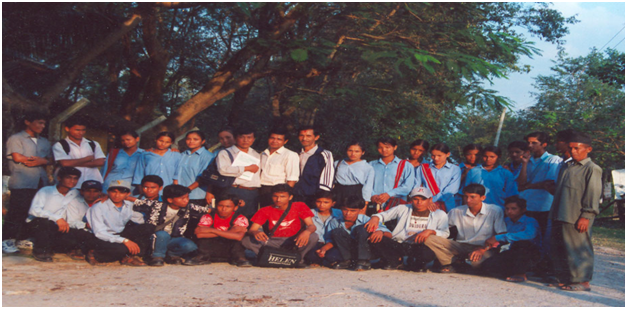
|
My focus has been always education first; this photo was taken after establishing an eco-club in their school -1993 (I am in the middle with a white shirt) |
1994 was the turning point of my life pattern. We had a new member in our family, daughter Manaslu. My active role of conservation in Nepal was acknowledged both locally and abroad. In the same year, my conservation work was aired in the radios, TVs, and newsletters (including Indian Journals). I got the invitation from the Jersey Wildlife Conservation Trust- the UK to attend the “Breeding and Conservation of Endangered Species Principles and Practice” course. That was my first overseas visit. Letter I was awarded a diploma from the University of Kent at Canterbury, UK on the basis of my high performance in training and my thesis on “A Study of the Wild Water Buffaloes (Bubalus bubalis arnee) in Koshi Tappu Wildlife Reserve, Sunsari Nepal” in 1995.
I was also serving as Assistant Professor at the Adarsha Night College, where I was admitted after the SLC. The World Conservation Union (IUCN) and World Wildlife Fund for Nature (WWF) also provided me a scholarship for the Environmental Educator course in India.
The conservation movement was already spread to sixteen districts of Eastern Nepal. At Bank, I got promotion as an officer, while I was involving with these verities of other activities. Basically, from 1986-1996, my time was to manage the permanent job at a bank, devote the time for conservation work and concentrate on teaching and educating the people as much as possible. About 18 hours were my normal working hours every day (without a break in a single day). My wife has been with me with the full support whatever, we have been doing, even today. If she has demanded of comforts, it would not possible to survive like a brand-new machine all the time.
Education-Research-Environment conservation and Social Empowerment
While doing the bank job, environment conservation work, my focus was still education and research. During that time, I complete two masters one from Nepal (M.A. Anthropology-1991), a postgraduate diploma from, Delhi (1992) indirectly involved in the democratic movement of Nepal and also managed several consultancy tasks. In 1996, I got the Netherlands government scholarships for two-year M.Sc. in environmental system monitoring and analysis (at ITC- now the University of Twente, Enschede, the Netherlands). This gave me a new direction to understand the basic principles of sustainable development. With Family, I stayed in the Netherlands for two years during the course. My dream to study science fulfilled after 16 years of the SLC. During the M.Sc. study period, I visit all western European countries and Kenya, Tanzania, and Uganda as a research student. The conservation work was still continued in Nepal. Still, I had not resigned the bank (I was in study leave). I returned back to Nepal in 1998, rejoined the bank, and began to work as usual 18 hours per day.
I continued my active involvement in conservation work, while I was studying in my country and abroad. As an activist and active conservationist, conservation is and has been the most important thing for me. In this respect, I would also like to mention that I have utilized most of my inherited property, and my wife’s property in the environment and wildlife conservation work. Serving nature and people have always taken priority over everything else. Therefore, we try to serve them by using all means accessible to us. I had nothing that was completely personal. My wife and I were always tried to serve people and the Earth.
The real essence of sustainable development through an MA in Sustainable International Development:
I left Nepal in 2002 for higher education in a Masters in Sustainable International Development. I completed my masters from Brandeis University, Waltham, Massachusetts in 2004, spend a year as optional practical trainees’. During the internship, I work at Pajero Jai Foundation as manager of Sustainability. I also work with the University of Adelaide, Australia under the UNEP sustainability education project under my mentor Dr. Jan Karey. This course gave me new direction and encouragement to continue my lifelong passion to serve nature and people. Holding the same spirit, I moved to Syracuse in 2005 for Ph.D. (environmental sociology) at Syracuse University under the mentorship of Professor Steven R. Brechin.
The new journey just begins- sustainability in question
I completed my Ph.D. from Syracuse University, New York in 2012, since then, a new journey is going on. The destination is still a bit far, however, I feel still I am learning about the world. I want to contribute to societal harmony, peace, and freedom. I see several severe problems i.e. the deteriorating peace in the world due to conflicts and violence; environmental degradation- climate change-loss of biodiversity and unsustainable development. Additionally, I see the poverty, and the lives in Slums in the developing world. Moreover, the mode if problems in the developing world and developed world seems different; however, they are omnipresent. To resolve them, both north and south need to join hands.
At a personal level, I want to devote myself to find a way to resolve these problems individually and as a group. Every problem has a solution. However, the problems of the contemporary world have very long roots; history and connections. We need to resolve these problems as they have emerged. In reality, through the research, conferences, experiences and the ground truth, we know some cause of the problems. However, more rigorous research is needed to find the root of anthropogenic hampers in nature. It is also necessary to resolve the humanitarian crisis, and the way to minimize the gaps between north and south. These long-rooted problems cannot be resolved overnights. We need to develop a global strategy, which can be implemented within a given time. There have been many international commitments to resolve the global crisis on the environment, health and food crisis. However, the implementation part depends on the leadership of individual countries. The individual countries are not being able to overcome from the neighborhood blame culture (the problem created by the south, they should solve, or by north, they should pay for that, etc.). In addition to that, at the global level, there is no specific program for the citizen empowerment. Until or unless, citizens do not have any stake in resolving the crisis, we cannot imagine implementing any program at the ground level, where the actual problem is situated. There is a strong need for long-term commitments, devotions, and actual work at the ground level. The fact is “world always dominated by the noble and kind-hearted people”. I am optimistic, problems are everywhere, individual to community, nations and at the globe; however, they can be solved, with collective efforts.
At the personal level, as I have experienced, I am very hopeful that doors will be opened, I am just waiting for another miraculous knock (as happened, at my primary to doctoral level study), which will provide a secure working platform, and I will not have to shift the babies (emerging thoughts) once place to another as wild cats do. I have still passion, perseverance, hope, and energy as I had in my school years. I am energizing for the next move, waiting for the noble and kind-hearted people to call me to begin the new journey.
Part -two
Journal: Now, we would like to know your opinion on sustainable development (SD)- Discourse, Boundaries, Creativity, Diversity, Goals, and Institutionalization. And
(1) Are the contemporary world’s economic and social phenomena favorable to the sustainability of the planet? (2) Do you think the proposed and implemented sustainable development goals of the United Nations are achievable?
Additionally, (3), How the world is responding to achieve SDGs and (4) How your research focused on countries like India, Nepal, Bangladesh, and Pakistan are responding to achieve the SDGs?
Prof. Bhandari: As you have discussed above, sustainability is the very complex/difficult and multidimensional approach to development. One can define, explain or theorize according to her / his situation. However, I do not mean that sustainable development does not have epistemological backing.
You have asked complicated but very important questions. However, firstly, I would like to start with
(1) Are the contemporary world’s economic and social phenomena favorable for the sustainability of the planet?
My answer is no…..and yes.
No in the sense that the contemporary world is on the path of self-centric paradigms where personal mentality governing process is “I, me, my” centric plus the world is functioning on competitive advantage notion. Where I centric modality runs with the principles of I should possess everything no matter what happens to other. In this arena the weak cannot complete with strong, poor cannot complete with rich (this applies at personal to national and international level). In relation to sustainable development, which has three pillars- Environment, Economic and Social, whereas economic pillar dominates the other two. The environmental (nature) has been a victim of development and there are no symptoms of equal treatments. For example, the rich are getting richer and the poor are getting poorer. The poor have to rely on the environment (nature and natural resources) and the rich blame them, symbolically, the contemporary world’s economic and social phenomena is not favorable for the sustainability of the planet.
Yes, because the world particularly United Nations (UN) and non-political actors have understood the fact that the contemporary worlds economic and social phenomena is not favorable and to change the unfavorable environment to favorable various efforts have been taken. Most importantly, since the first United Nations Conference on the Human Environment 1972, the UN has been trying to convince its member nations that, the world’s development pattern is not favorable to the planet earth. ‘A point has been reached in history when we must shape our actions throughout the world with more prudent care for their environmental consequences. Through ignorance or indifference, we can do massive and irreversible harm to the earthly environment on which our life and wellbeing depend. Conversely, through fuller knowledge and wiser action, we can achieve for ourselves and our posterity a better life in an environment more in keeping with human needs and hopes … To defend and improve the human environment for present and future generations has become an imperative goal for mankind’ (United Nations 1972). This statement shows a clear concern of the global environment. In addition to that many scholars are warning to the world community about the consequences of overutilization of natural resources on the name of development. In 47 years from the first UN conference, many efforts have been taken. The latest and most important is the UN General Assembly on 25 September 2015, which adopted the Sustainable Development Goals (17 goals and 169 targets). Resolution adopted by the General Assembly under the heading of Our world today (No 14 p5) states that “Billions of our citizens continue to live in poverty and are denied a life of dignity. There are rising inequalities within and among countries. There are enormous disparities of opportunity, wealth and power. Gender inequality remains a key challenge. Unemployment, particularly youth unemployment, is a major concern. Global health threats, more frequent and intense natural disasters, spiraling conflict, violent extremism, terrorism, and related humanitarian crises and forced displacement of people threaten to reverse much of the development progress made in recent decades. Natural resource depletion and adverse impacts of environmental degradation, including desertification, drought, land degradation, freshwater scarcity and loss of biodiversity, add to and exacerbate the list of challenges which humanity faces. Climate change is one of the greatest challenges of our time and its adverse impacts undermine the ability of all countries to achieve sustainable development. Increases in global temperature, sea level rise, ocean acidification, and other climate change impacts are seriously affecting coastal areas and low-lying coastal countries, including many least developed countries and small island developing States. The survival of many societies, and of the biological support systems of the planet, is at risk” (Transforming our world: the 2030 Agenda for Sustainable Development-UN 2015-https://www.unfpa.org/sites/default/files/resource-pdf/Resolution_A_RES_70_1_EN.pdf).
It is noteworthy to illustrate that, UN with all its member countries, accepts and acknowledge the dreadful condition of the planet. As a consequence, there are tremendous efforts have been taking place from governments to the civil societies, community and as well as households and personal level. As we saw in the first part of the discussion, if there is an understanding of the problems, the solutions have to come, no matter at what cost. So, globally acceptance of the problem gives the room to say that the contemporary world’s economic and social phenomena are not favorable for the sustainability of the planet, however, efforts to minimize the problems have been taken.There is no certainty at all, however, the notion of sustainability has given a hope (it can be false but the hope is there).
“It has been frequently observed that wealthy countries have benefited disproportionately from the activities that have caused global warming, while poor countries suffer disproportionately from the impacts (Mahlstein et.el 2011; Hansen and Sato 2016; Davis and Diffenbaugh 2016; Ravallion et.al 2000; Duro and Padilla 2006). Our results show that, in addition to the direct benefits of fossil fuel use, many wealthy countries have likely been made even more wealthy by the resulting global warming. Likewise, not only have poor countries not shared in the full benefits of energy consumption, but many have already been made poorer (in relative terms) by the energy consumption of wealthy countries. Given the magnitude of the warming-induced growth penalties that poor countries have already suffered, expansion of low-carbon energy sources can be expected to provide a substantial secondary development benefit (by curbing future warming-induced growth penalties), in addition to the primary benefits of increased energy access” (Diffenbaugh and Burke 2019:9812).
This quote of Diffenbaugh and Burke (2019) gives a
Journal: (2) Do you think the proposed and implemented sustainable development goals (SDGs) of the United Nations are achievable?
Prof. Bhandari: My answer is not different than as we discussed above. Basically, SDGs are based on success and limitation of Millennium Development Goals.
Relationship between MDGs and SDGs at the Goal Level
Millennium Development Goals (2000-2015) |
Sustainable Development Goals (2016-2030) |
|---|---|
MDG 1. Eradicate extreme poverty and hunger |
SDG 1. End poverty in all its forms everywhere |
MDG 2. Achieve universal primary education |
SDG 4. Ensure inclusive and equitable quality education and promote lifelong learning opportunities for all |
MDG 3. Promote gender equality and empower women |
SDG 5. Achieve gender equality and empower all women and girls |
MDG 4. Reduce child mortality MDG 5. Improve maternal health MDG 6. Combat HIV/AIDS, malaria and other diseases |
SDG 3. Ensure healthy lives and promote well-being for all at all ages |
MDG 7. Ensure environmental sustainability |
SDG 6. Ensure availability and sustainable management of water and sanitation for all |
MDG 8. Develop a global partnership for development |
SDG 17. Strengthen the means of implementation and revitalize the global partnership for sustainable development |
|
SDG 16. Promote peaceful and inclusive societies for sustainable development, provide access to justice for all and build effective, accountable and inclusive institutions at all levels |
Source: SESRIC 2016:39. http://www.sesric.org/files/article/568.pdf
SDGS are developed on the established principles of MDGs, which only partially obtained within the targeted time frame 2001-2015. More importantly, SDGs are based on past experience with broader participants from both north and south.
SDGs seems practical than MDGs, for example, MDGs has 8 goals and 18 targets, based on these, SDGs has 17 goals and 169 targets. In SDGs, each goal has agendas and pathway to achieve them. SDGs goals and agendas are more comprehensive, more stakeholder engagement oriented and public-private partnership in development. SDGs uses the integrative approach for development with the universal principles with clear outlines of how developed countries can help to develop the world and how developed world will also benefit (Boucher 2015). If there are strong commitments to achieve any objective, it is not impossible, however, the current scenarios of the divisive world, the path to achieving the SD Goals are not easy.
Journal: (3), How the world is responding to achieve SDGs?
Prof. Bhandari: It is to early to evaluate the response because many countries have even not included the SDGs in their development plans. And even included countries have not established the policies architecture of how the goals will be fit in their national programs and how to target will be achieved. The case of developing world is not easy because they are struggling with “Natural resource depletion and adverse impacts of environmental degradation, including desertification, drought, land degradation, freshwater scarcity and loss of biodiversity” (UN 2015). They are under the burden of Poverty and poverty-related all illness and facing a strong downfall of resource scarcity to tackle the new problems due to climate change for which they are not only responsible actors. Even the most advanced countries G 20, are not being able to cope with the SDGs programs. Lack of economic resources, appropriate institutional arrangements; suitable monitoring evaluation tools and shortage of appropriate professional manpower are the major challenges toward achieving SDGs. In so far, as indicated in the “SDG Index and Dashboards Report 2018- G20 and Large Countries Edition” there is very minimal progress in achieving the SDGs even among the highly developed G 20 nations (Bertelsmann Stiftung and Sustainable Development Solutions Network 2018). If so, what is the condition of developing countries? Unknown.
Report summarizes:
- Most G20 countries have started SDGs implementation, but important gaps remain.
- No country is on track towards achieving all SDGs.
- Conflicts are leading to reversals in SDG progress.
- Progress towards sustainable consumption and production patterns is too slow.
- High-income countries generate negative SDG spillover effects.
- Inequalities in economic and social outcomes require better data (page IX).
In the same line,
“To achieve the SDGs, countries must undertake major transformations of education, health, energy systems, land-use, urban development, and many other dimensions. Each transformation requires long term changes involving large numbers of stakeholders from government, business, and civil society. Since such complex transformations cannot be implemented by markets alone, governments must take the lead in mobilizing stakeholders, planning for the transformations, designing supporting policy processes, and mobilizing the public funding” (Bertelsmann Stiftung and Sustainable Development Solutions Network 2018:1).
Egron-Polak (2019) rightly shows the future directions to achieve the SDGs “SDGs address all nations – North, South, East, and West; The 17 SDGs are all inter-connected and show that solutions are interdependent; need holistic (multi-disciplinary) approaches; No SDG can be achieved without involvement – through research, education, and outreach – of higher education institutions; None can be achieved without international collaboration and commitment; Current trajectories of development (including in HE) are unsustainable – economically, socially, and politically; International education and research can serve to raise awareness, be at forefront of search for alternatives, demonstrate centrality of both knowledge and collaboration, gain new impetus by building on other broad agendas’. SDGs are global agendas and unified international efforts are needed to achieve them practically. Institutionalization is a process (Scott 2001), has to cross several prerequisites; similarly, internationalization also needs combined efforts at the multinational level.
Journal: (4) How your research focused on countries like India, Nepal, Bangladesh, and Pakistan are responding to achieve the SDGs?
Prof. Bhandari: The four South Asian countries stretch from the towering Himalayan peaks of Nepal to the fertile delta of Bangladesh and peninsula of India and the Indian Ocean.
As ADB (2010) highlights these four countries cover verities of climatic zones as diverse as its physical landscape, the region is experiencing an array of climate change impacts, including glacial melt, forest fires, rising sea levels, mountain and coastal soil erosion, and saline water intrusion. Abnormal monsoon patterns and more frequent and intense storms have aggravated natural disasters and climate change impacts in recent years. Bearing the brunt of these are the more than 600 million absolute poor—more than half of the world’s total poor—living in the region, who depend on climate-sensitive sectors including agriculture, forestry, and traditional fishing for much of their day-to-day needs. With changes in the global climate system likely to span into the next century, geography, high population density, and immense poverty will continue to make South Asia especially vulnerable. Human health, biodiversity, agricultural production, food security, water, energy, and coastal settlements will be imperiled, as natural disasters worsen, and migration grows—intensifying stresses on major cities (ADB 2010:3).
Due to climatic variation and the lack of the capability to utilize the mitigation option mostly the poorest of the poor are the innocent victims of the adverse impact of climate change. As seen in the figures above flood is the main disaster in the region followed by the landslides, windstorms, sea surges, cyclones, and droughts. Bangladesh and Nepal face the highest number of waters born disaster i.e. floods and landslides; and Bangladesh, India, and Pakistan face the frequent windstorms, sea surges, droughts, and cyclones. All severe impacts of climate change cut across boundaries.
All four countries have developed policy directives and various plans, to address the issue with the collaborations of various international organizations including the multilateral and bilateral donor and development agencies, UN agencies, international conservation organizations such as IUCN, WWF, Winrock International, etc. (Bhandari, 2018,2019).
All four countries have the same environmental problems such as deforestation; soil erosion; overgrazing; desertification; loss of biodiversity; air pollution; water pollution; huge population base and large growth rate is overstraining natural resources; natural disasters such as floods, cyclones (except Nepal) and landslides are common; high death rates and ailments associated with indoor air pollution. The major underlying cause is deforestation, which is associated with the public dependency on natural resources for the livelihood. In the region, largely still people rely on the forest product for the energy source. This places enormous stress on forest resources. Similarly, unplanned development has also led the serious environmental problems in the region, for example, the diversion or alteration of the rivers flow through dams and channels has seriously reduced stream flows in Nepal, India, Bangladesh, and Pakistan (dams can be seen in all major river systems in these countries) also raised the regional tensions. Following, the same track of the problem, there is also an increasing trend of environmental hazards related to human health. The environmental health problems can either be due to lack of access to essential environment resources (clean air, water, shelter adequate food, etc.,) and due to unhealthy and unsafe work environments (Climate change in Asia 2007; ESPASSA 2008; Government of India 2009, 2010; Government of Nepal 2009; Government of Pakistan 2009; Bangladesh Centre for Advanced Studies 2010; ESCAP 2010).
The four countries are also facing various conflicts due to the transboundary nature of environmental problems; the best example is the transboundary water resource management issues between Nepal and India and between India and Bangladesh. Largely conflicts occur in these four Asian countries, mainly among the local stakeholders in terms of use and share; it occurs due to the unequal profit distribution from forest resources; imbalance of knowledge in forestry creating imbalance of power and mistrust; dominance of interests over fodder and fuel-wood and exclusion of local people from access to forest, corruption in forest administration and local forest user groups (or local elites) and conflict of interest among the stakeholders. It seems that until or unless people have alternatives accept the natural resource for the livelihood the conflict will remain there as unavoidable fact. Therefore, in the South Asian societies, the conflict on natural resource management will not easily be solved. However, these four countries also established the common forum SAARC to tackle the problems jointly and raised the strong voices in the international conservation forums (Climate change in Asia 2007; ESPASSA 2008; Government of India 2009, 2010; Government of Nepal 2009; Government of Pakistan 2009; Bangladesh Centre for Advanced Studies 2010; ESCAP 2010).
Nepal, Bangladesh, and Pakistan have been facing the problem of political unrest, growing population pressure, extreme poverty and insecurity since quite a long time, therefore these countries are still lacking in the reform process. Among them, India has a strong economy and stability in the governance system. However, in natural resource conservation, Nepal’s exemplary situation of conservation of forest and protected area management is not dismissed, even in regular violence and insecurity. As a result, the protected area land escape is reached one of the highest with the area of 34,186.62 sq. km that is 23.23 percent of the total area. The region is not only the house of the modern civilization but also has organized civil society system, which has been playing a crucial role in national development. Equally, each country has or creating relatively organized development mechanism to address the development and conservational issues (Agrawal 2005; Bhandari 2017, 2018).
Having such a problematic situation South Asian nations have not been able to work on the issues of sustainable development goals as needed. However, each country has submitted to the national report to the United Nations and shown the commitments to achieve the SDGs.
And at the end:
It is my pleasure to share knowledge and expertise As I noted, earlier, my family, communities, and various societies (wherever I have been), including nature and culture, traditions combined nurtured me, without any expectations. My intention, of life, is to give or contribute to the society in fullest whatever I have. I would be more than happy if readers find this information useful. I am open to engaging in any kind of collaborative research, teaching, or any other tasks which can contribute to overcome or minimize the devastating impact of climate change.
I would like to clearly state that, most of the information, I have noted in this interview are based on web-search as well as taken from my forthcoming books manuscripts
Green Web II, Standards and Perspectives from the IUCN (2018), River Publishers, Denmark / the Netherlands https://www.amazon.com/Green-Web-II-Perspectives-Conservation-Environmental/dp/8770220123/ref=sr_1_1?ie=UTF8&qid=1534358502&sr=8-1&keywords=medani+bhandari
Getting the Facts Right: The IPCC and the Role of Science in Managing Climate Change, (under contract) River Publishers, Denmark / the Netherlands
Most of the pictures, graphs, tables are taken from the websites. I have tried to provide proper sources, citations, and links of the original sources. However, if I missed noting any source, I apologize in advance to all concern authors, journalists, government agencies and any other stakeholders whom I have cited in this note.
Acknowledgments:
Janani Janmabhoomischa Swargadapi Gariyasi- जननी जन्मभूमिश्च स्वर्गादपि गरीयसी (Mother and mother-land are far superior to even the heaven).
First of all, I would like to offer my thankfulness to my Mother, Heema Devi, no one can be like you, and it applies to all mothers (future mothers) and mother earth. One can’t count mothers’ contributions. Mother is mother, until or unless we do not feel mothers, selfless love, we cannot understand mother nature’s love and contribution to us or to all living beings.
And I would also like to acknowledge the contribution of my family members my wife Prajita, son Prameya, daughter Manaslu and daughter in law Kelsey Bhandari as well as my brother Krishna, Hari, sisters Kali, Bhakti, Radha, Bindu, Sita and their family are always with us for our conservation journey. Our uncle Bhim Prasad Bhandari and Kaki and brothers Govinda, Bishnu, Rudra, and Bishma have been always our supporter. Prajita’s parents Dwarika Natha and Durga Devi, as well as brother and sisters Basudev, Ramesh, Rishi as well as Dhurba Acharya, Binod Acharya, Ranjan Newpane and Annapurna, Bijaya, Jaya, Ajaya and entire family, have been blessing hands to us. If the family is was not supportive, my conservation journey would be interrupted or simply not possible. It applies to all of us all human as a social being. Here I would like to refer previous interview “BashudaivaKutumbakkam”- The entire world is our home and all living beings are our relatives. Why we need to worry about climate change, with reference to pollution problems in the major cities of India, Nepal, Bangladesh, and Pakistan.
In which I have illustrated how nature, culture, our neighbor and the biophysical environment help to shape the personal attitude.
I feel so fortunate that I even cannot count and remember the names, who helped me to shape my ideas and helped to grow. In my high schooling- which was six hours walk each day-my teacher knew that and if I could not reach on time to school all teachers were always restless and worried. Their love was unconditional and still, they love me wherever they are. College time- in Banaras, Damodar Guru, Dilliram Guru, Dhungana Guru and all Gurus of Dr. Ram Manohar Lohiya Degree College, Vairabtalab, Banaras- they knew that I was kind of travel student, so their willingness to support me was amazing. Morang college, Biratnagar- Bhaktalal Upadhaya (who was also working under my chairmanship in APEC), Shesnarayan Karna, Krishna Bhandari, Dr. Bhes Prasad Dhamala, Dr. Ram B. Thapa, and many more were always worry about me not about my study but about my health. TU-Kathmandu- in my Masters in Anthropology- Dr. Rishikeshab Raj Regmi, Dr. Bishnu Bhandari, and my friend circle- Shambhu Kattel -without him I would not pass my MA with first division. My friend Sanjay Mishra, who always insisted me for better and better Ram Prasad Guragai and many more have so much contribution.
The poetry and creative writing-we used to have weekly poetry reciting session in Biratnagar, Naredra Chapagai who wanted to see me as a winner in creative writing. Balakrishna Pokherel, Bhanubhakta Pokhrel, Krishabhusan Bal (who also work with me in APEC), and other poet friends circle Dadhiraj Subedi (GURU), Kabiraj Newpane (Guru), Biwas Pokhrel, Gokul Adhikari, Mahesh Prasai, Syam Adhikari, Pramod Pradhan, Laxman Nawatia, Kisor Biswakarma, Radhesyam Lekali, Jiva Nath Dhamala, Narayan Tiwari, Indira Prasai, Laxmi Upreti, Mithila Devkota, Ananta Newpane, Bajay Khanal, Sridhar Bhandari and many more were senior or contemporary, who always help to me and Prajita to craft noble thoughts and poems.
In Kathmandu, my uncle Dr. Tara Nath Sharma and aunty Shanta Sharma have been always supportive in our move as guardian. Each and every staff of Departments of National Parkes and Wildlife Conservation were always in front to support our conservation mission. Especially Narayan Paudel’s support was unconditional. Most of the NGOs and IUCN-Nepal, WWF-Nepal, ICIMOD, and other international organizations were also very supportive.
The staff of Rastriya Banijya Bank always supported me even they allow me to make plantation to every branch I visited (Krishna Sharma, Tekraj Joshi, Medani Bhattarai, Prasant Banskota, etc. have special support). My friends in conservation Govinda Luitel, Durga Paudel, Mayer and Deputy Mayer of Gularia Municipality Govinda Pandeya and Hari Gyawali were always supportive.
When I was in Great Britain the staff of Durrell Wildlife Trust, when I was in the Netherlands, the staff and professors of ITC, (including my friends Ananda Bhandari, Santosh, Umesh, Bigyan), in Kenya- the Masai Mara Wildlife reserve staff, as well as Masai themselves, in Australia- Adelaide University staff and professors, Sai Group of South Australia, in Center for Environment Education- India, all staff and my friends like Tirunabh Garashu have supported us unconditionally. In the USA we are always supportive hands- William Katz, Edward Tadashi, William Tupie, Jim Brunton (Boston); Samuel Sage, Patricia Burak, Cecelia Green, Steven Brechin, Jakie Orr, and Nepali community – Syracuse; Jahid Rahaman and Masum Mohammad, Abu Kamal in Indianapolis; my brother Suresh Bhandari, sister in law Saru and Kaka Kaki in Texas, Kiran Pokhrel and family and Saidham Canada -Guru Bikash and Guruma Suvra and Sai family have been pouring us unconditional support.
Dr. Ambika Adhikari, Prof. Keshav Bhanttarai, Dr. Krishna Oli, Ukesh Bhuju, Dr. Top Khatri, Dr. Narendra Pradhan, Dr. Ram Prakash Yadav, Prof. Bidhan Acharya, Krishna Murari Nepal, Shyam Gautam, MurariDhoj Silawal, Hom Kumari Risal, Dr. Rishi Bikram Shah, Dr. Puru Shrestha, Mohan Gurung, Gopal Bhattarai, Ananda Bhandari, Basu Dev Lohani, Santosh Nepal, Munni Gautam, Dr. Bijay Kattel, Dr. Jay P. Shah, Dr. Udhaya Raj Sharma, Kali Prasad Pokhrel, Batu Krishna Uprety, Puspa Bhandari, Naredra Bhandari, Ciranjibi Bhandari, Pashupati Gautam. Ram Chandra Gautam, Meghamani Gautam, Govinda Luitel and family, Manish, Yagya, Abhimanyu Aier Dhir Prasad Bhandari, Indra Bhandari, Khem Bhandari, Niraj Mishra, Nilam Niraula, Divya Pradhan and many other scholars have tremendous help and support in our conservation journey.
In Virginia- My childhood friend Rajan Adhikari and his family, Medini Adhikari and family, Gunaraj Luitel and family, Parsuram Bhandari and family, Dr. Gopi Uprety and family, Arjun Dhungel and his family, Krishna Basnet, Suman Timsina (my Guru brother), Sneha Didi, Murari Naral and family, Durga Kharel and family, Prasanta Pokhrel and family and Sai Pariwar of Virginia etc. have been standing with me in my conservation and research journey. Similarly, in Hawaii my coworker; and students at Akamai University and President Douglas Capogrossi; likewise, my colleague Shvindina Hanna and all colleagues and students at Sumy State University, Ukraine have been always supportive with all possible way. My colleagues at Arabian Gulf University, Bahrain, - Dr. Mohammad Sulaiman Ali Abido, Dr. Odeh Al-Jayyousi, Dr. Thamer Salim Ali Al-Dawood, Dr. Ahmed O. El-kholei, Dr. Yas Al-Sultani etc. and all of my students as well as Nepali circle in Bahrain- Durga Giri, Kumar BK, Rajkumar Basnet, Kamal Shrestha, Khagaraj Pandey, Krishna Hamal Thakuri and all friends, Nepal Embassy- Bahrain- all Nepali clubs, the ISCON temple family etc. also have tremendous support in our conservation journey. My all Facebook friends (https://www.facebook.com/medani.bhandari.7 / 1000), LinkedIn friends (https://www.linkedin.com/in/medani-bhandari-ph-d-8611a018/ 16000), Tweeter https://twitter.com/medani_bhandari?lang=en also encouraging me one way or another. Thank you to you all.
In sum-up, there are so many people who have been helping and supporting our conservation journey- the list of supportive hands can be pages and pages, so I will stop here but would like to salute you all and thank you to you all. Finally, I humbly, I honor thank again and again to my Gurus and parents because they love without return expectation, and only want to see the success. Thank you!!!
References
- ADB (2009) ADB Support for Public Sector Reforms in the Pacific: Enhance Results through Ownership, Capacity, and Continuity, Manila.
- ADB (2009) Building Climate Resilience in the Agriculture Sector in Asia and the Pacific, Manila: ADB / International Food Policy Research Institute.
- ADB (2010) Climate Change in Asia, Strong Response for Sustainable Future, Issues, Impact and Responses, Asian Development Bank, 6 ADB Avenue, Mandaluyong City, Manila, Philippines http://www.adb.org/documents/reports/climate-change-sa/climate-change-sa.pdf
- ADB (2010) Moving from Concept to Action, Asian Experiences on Managing for Development Results, Asia-Pacific Community of Practice on Managing for Development Results [http://cop-mfdr.adb.org] Compiled by the Secretariat of the Asia-Pacific Community of Practice on MfDR, The Results Management Unit Asian Development Bank, 6 ADB Avenue, Mandaluyong City, 1550 Metro Manila, Philippines http://www.adb.org/documents/produced-under-ta/39322/39322-01-REG-DPTA/39322-01-REG-DPTA.pdf
- Agrawal, Arun (2001) The Regulatory Community Decentralization and the Environment in the Van Panchayats (Forest Councils) of Kumaon, India, Mountain Research and Development Vol 21 No 3: 208–211. http://www-personal.umich.edu/~arunagra/papers/The%20Regulatory%20Community.pdf (accessed on 04/27/2019)
- Agrawal, Arun (2005) Environmental Community, Intimate Government, and the Making of Environmental Subjects in Kumaon, India, Current Anthropology Volume 46, 2:161-190
- Bangladesh Bureau of Statistics (1998, 1999 and 2010), Government of Bangladesh, Dhaka http://www.asianphilanthropy.org/countries/bangladesh/size.html
- Bangladesh Bureau of Statistics (2002), BBS, Government of Bangladesh, Dhaka
- Bangladesh Bureau of Statistics (2009) Report on Monitoring of Employment Survey-2009, Bangladesh Bureau of Statistics (BBS) Parishankhyan Bhaban, E-27/A, Agargaon Sher-e-Bangla Nagar, Dhaka-1207, Bangladesh http://www.bbs.gov.bd/Home.aspx
- Bangladesh Centre for Advanced Studies (2010) Bangladesh Wetland Ecosystem- Information and Knowledge Base, BCAS, Dhaka
- Bhandari, Medani P. (2018). “Climate Change Impacts on Food Security, a Brief Comparative Case Study of Bangladesh, India, Nepal, and Pakistan". Acta Scientific Agriculture 2.8 (2018): 136-140. https://www.actascientific.com/ASAG/pdf/ASAG-02-0157.pdf
- Bhandari, Medani P. (2018). Green Web-II: Standards and Perspectives from the IUCN, Published, sold and distributed by River Publishers, Denmark / the Netherlands ISBN: 978-87-70220-12-5 (Hardback) 978-87-70220-11-8 (eBook). http://www.riverpublishers.com/book_details.php?book_id=568
- Bhandari, Medani P. (2018). The Problems and Consequences of the Biodiversity Conservation: A Case Study from Bangladesh, India, Nepal, and Pakistan.SocioEconomic Challenges, 2(1), 6-20. http://armgpublishing.sumdu.edu.ua/wp-content/uploads/2016/12/files/sec/volume-2-issue-1/Medani%20P.%20Bhandari_SEC_1_2018.pdf
- Bhandari, Medani P. (2019). “BashudaivaKutumbakkam”- The entire world is our home and all living beings are our relatives. Why we need to worry about climate change, with reference to pollution problems in the major cities of India, Nepal, Bangladesh, and Pakistan. Adv Agr Environ Sci. (2019);2(1): 8−35. DOI: 10.30881/aaeoa.00019 http://ologyjournals.com/aaeoa/aaeoa_00019.pdf
- Boucher, Lauren (2015). Sustainable Development Goals vs. Bertelsmann Stiftung and Sustainable Development Solutions Network (2018), SDG Index and Dashboards Report 2018-Global Responsibilities, Implementing the Goals, G20 and Large Countries Edition. www.pica-publishing.com, http://www.sdgindex.org/assets/files/2018/00%20SDGS%202018%20G20%20EDITION%20WEB%20V7%20180718.pdf
- CIA (2010) The World Fact Book, Government of the United States of America, The Central Intelligence Agency, Office of Public Affairs, Washington, D.C. (Accessed on 11/17/10) https://www.cia.gov/library/publications/the-world-factbook/geos/pk.html (Pakistan) https://www.cia.gov/library/publications/the-world-factbook/geos/bg.html (Bangladesh) https://www.cia.gov/library/publications/the-world-factbook/geos/np.html (Nepal) https://www.cia.gov/library/publications/the-world-factbook/geos/in.html (India)
- CIA-The World Factbook (2009) the United States Central Intelligence Agency, CIA-The Government of the United States of America, Washington DC. https://www.cia.gov/library/publications/the-world-factbook/geos/pk.html (accessed on 06/09/2010)
- Climate change in Asia (2007) Background Paper Impacts, vulnerability and adaptation to climate change in Asia, Beijing, China 11-13 April 2007, This paper was commissioned by the Secretariat of the United Nations Framework Convention on Climate Change and prepared by Mozaharul Alam, Atiq Rahman, Mariam Rashid, Golam Rabbani, Preety Bhandary, Suruchi Bhadwal, Murali Lal, and Moekti Handajani Soejachmoen. In some parts of the document, the Secretariat introduced modifications. http://unfccc.int/files/adaptation/methodologies_for/vulnerability_and_adaptation/application/pdf/unfccc_asian_workshop_background_paper.pdf
- Davis SJ, Diffenbaugh NS (2016) Dislocated interests and climate change. Environ Res Lett 11:61001.
- Diffenbaugh, Noah S. and Marshall Burke (2019), Global warming has increased global economic inequality, PNAS May 14, 2019, 116 (20) 9808-9813; first published April 22, 2019 https://doi.org/10.1073/pnas.1816020116 Edited by Ottmar Edenhofer, Potsdam Institute for Climate Impact Research, Potsdam, Germany, and accepted by Editorial Board Member Hans J. Schellnhuber March 22, 2019 (received for review September 16, 2018) https://www.pnas.org/content/116/20/9808 https://www.pnas.org/content/pnas/116/20/9808.full.pdf
- Duro JA, Padilla E (2006) International inequalities in per capita CO2 emissions: A decomposition methodology by Kaya factors. Energy Econ 28:170–187.
- Ecosystem Services and Poverty Alleviation Study in South Asia (ESPASSA) (2008) A Situation Analysis for India and the Hindu Kush Himalayan Region. New Delhi: The Energy & Resources Institute.
- Egron-Polak, Eva (2019), Sustainable Development Goals: a New Framework for the Future of International Higher Education? World Education News plus Reviews. https://wenr.wes.org/2018/02/sustainable-development-goals-a-new-framework-for-the-future-of-international-higher-education
- ESCAP (2010) Statistical Yearbook for Asia and the Pacific 2009 (Published: March 24, 2010) The United Nations Economic and Social Commission for Asia and the Pacific (ESCAP), The United Nations Building, Rajadamnern Nok Avenue, Bangkok, Thailand http://www.unescap.org/stat/data/syb2009/ESCAP-SYB2009.pdf
- Griffin, D. M.; Shepherd K. R.; and Mahat T. B. S. (1988) Human Impact on Some Forests of the Middle Hills of Nepal, Part 5. Comparisons, Concepts, and Some Policy Implications, Mountain Research and Development, Vol. 8, No. 1: 43-52
- Government of India (2009) National Wetland Conservation Program Guidelines for Conservation and Management of Wetlands in India, Conservation and Survey Division Ministry of Environment and Forests Government of India, New Delhi
- Government of India (2010) Climate Change and India: A 4x4 Assessment a Sectoral and Regional Analysis for 2030s INCCA Report #2 INCCA: Indian Network for Climate Change Assessment November 2010 Ministry of Environment & Forests Government of India http://moef.nic.in/downloads/public-information/fin-rpt-incca.pdf
- Government of Nepal (2009) Nepal Major Activities on Climate Change Regime, Government of Nepal, Ministry of Environment, Science and Technology (MoEST), Singhdarbar, Kathmandu, Nepal www.most.gov.np/np/downloads/cc%20activities.doc (accessed on 08/26/2010)
- Government of Pakistan (2009) Implementation of the UU Framework Convention on Climate Change (UNFCCC) in Pakistan (presented by Ahmad Jan Malik Section Officer (NCS-1), Ministry of Environment, Islamabad, http://www.ap-net.org/docs/14th_seminar/malik.pdf
- Hansen J, Sato M (2016) Regional climate change and national responsibilities. Environ Res Lett 11:34009
- http://www.nationmultimedia.com/detail/opinion/30364167
- https://populationeducation.org/sustainable-development-goals-vs-millennium-development-goals-what-you-need-know/
- Intergovernmental Panel on Climate Change (2012) Managing the Risks of Extreme Events and Disasters to Advance Climate Change Adaptation, ed Field CB, et al. (Cambridge Univ Press, Cambridge, UK).
- Intergovernmental Panel on Climate Change (2013) Climate Change 2013: The Physical Science Basis. Contribution of Working Group I to the Fifth Assessment Report of the Intergovernmental Panel on Climate Change (Cambridge Univ Press, Cambridge, UK), pp 1311–1394.
- Intergovernmental Panel on Climate Change (2014) Climate Change 2014: Impacts, Adaptation, and Vulnerability. Contribution of Working Group II to the Fifth Assessment Report of the Intergovernmental Panel on Climate Change, ed Field CB, et al. (Cambridge Univ Press, Cambridge, UK), pp 1–32
- Mahlstein I, Knutti R, Solomon S, Portmann RW (2011) Early onset of significant local warming in low latitude countries. Environ Res Lett 6:34009.
- Om, Krishna (2016), Environmental Discourses in the Vedic Period, International Journal of Social Science and Humanities Research, Vol. 4, Issue 1, pp: (683-687), www.researchpublish.com
- Ravallion M, Heil M, Jalan J (2000) Carbon emissions and income inequality. Oxf Econ Pap 52:651–669.
- Sarmah, Rajib (2015), Environmental awareness in the Vedic literature: An assessment, International Journal of Sanskrit Research 2015; 1(4): 05-08, http://www.anantaajournal.com/archives/2015/vol1issue4/PartA/Sanskrit-12-1-2-28.pdf
- Scott, W. R. (2001). Institutions and Organizations: Foundations for organizational science. (2nd Ed.) Thousand Oaks, Ca: Sage.
- Scott, W. R. (2003). ‘Institutional carriers: reviewing models of transporting ideas over time and space and considering their consequences’. Industrial and Corporate Change, 12, 879-894.
- The Times World Universities Insight Limited (2019), future plan, The Times World Universities Insight Limited, Lindon, https://www.timeshighereducation.com/about-us
- Uchoa, Pablo, BBC World Service (2019), Climate change is driving the wealth gap in more ways than we think. 6 May 2019, http://www.bbc.com/capital/story/20190502-how-global-warming-has-made-the-rich-richer
- UNDESA-DSD – United Nations Department of Economic and Social Affairs Division for Sustainable Development, 2002. Plan of Implementation of the World Summit on Sustainable Development: The Johannesburg Conference. New York. UNESCO – United Nations Educational, Scientific and Cultural Organization, 2005. International Implementation Scheme. United Nations Decade of Education for Sustainable Development (2005-2014), Paris.
- UNEP (2010), Background paper for XVII Meeting of the Forum of Ministers of Environment of Latin America and the Caribbean, Panamá City, Panamá, 26 -30 April 2010, UNEP/LAC-IG.XVII/4, UNEP, Nairobi, Kenya
- UNESCO (2013), UNESCO’s Medium-The Contribution of Creativity to Sustainable Development Term Strategy for 2014-2021, http://www.unesco.org/new/fileadmin/MULTIMEDIA/HQ/CLT/images/CreativityFinalENG.pdf
- United Nations (2015), Transforming our world: the 2030 agenda for sustainable development. New York (NY): United Nations; 2015 (https://sustainabledevelopment.un.org/post2015/transformingourworld, accessed 5 October 2015).
- United Nations Educational, Scientific and Cultural Organization (UNESCO) (2009), Bonn Declaration. UNESCO World Conference on Education for Sustainable Development, Bonn, Germany, 31 March to 2 April 2009. http://www.esd-world-conference-2009.org/fileadmin/download/ESD2009_BonnDeclaration080409.pdf.
- United Nations. (1972), Declaration of the United Nations Conference on the Human Environment, Stockholm, 16 June 1972. Available: http://www.unep.org/Documents/Default.asp?DocumentID=97&ArticleID=1503
- Dangerfield, Whitney (2007), India’s Holiest City, At Varanasi, Hindu pilgrims come to pray—and to die—along the sacred Ganges River, SMITHSONIAN.COM https://www.smithsonianmag.com/travel/indias-holiest-city-146464495/
- Danish Raza, Hindustan Times, May 31, 2019. https://aleksandradynas.myportfolio.com/eleventh-hour
- A long way to Moksha, by Aleksandra Dynas,
- By AFP Published: February 14, 2019, Salvation House - where Hindus go to die, THE EXPRESS TRIBUNE > WORLD
- Moni Basu, Hotel Death- CNN (Photographs by Atul Loke/Panos Pictures for CNN), https://www.cnn.com/interactive/2014/04/world/india-hotel-death/index.html
- Photo_ Seeking salvation in Varanasi’s homes for the dying _ India-news _ photos _ Hindustan Times-Sachit Khanna /HT Photo-
- Salvation House – where Hindus go to die opinion February 15, 2019, 01:00 By Agency France-Presse, Varanasi, India
- Search for salvation: In Varanasi, establishments offer moksha-seekers a place to await death, https://www.hindustantimes.com/india-news/search-for-salvation-in-varanasi-establishments-offer-moksha-seekers-a-place-to-await-death/story-8yyZ5jHRWZwHRRNxlVIiAO.html
- https://tribune.com.pk/story/1910229/3-salvation-house-hindus-go-die/
